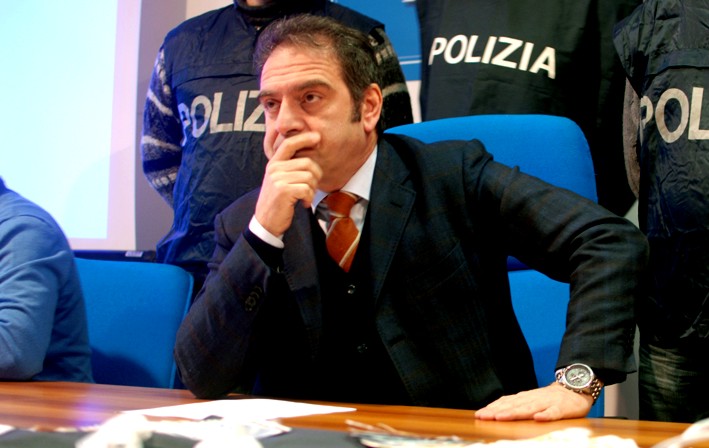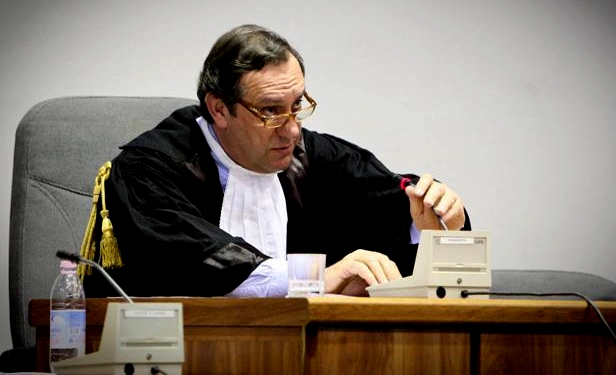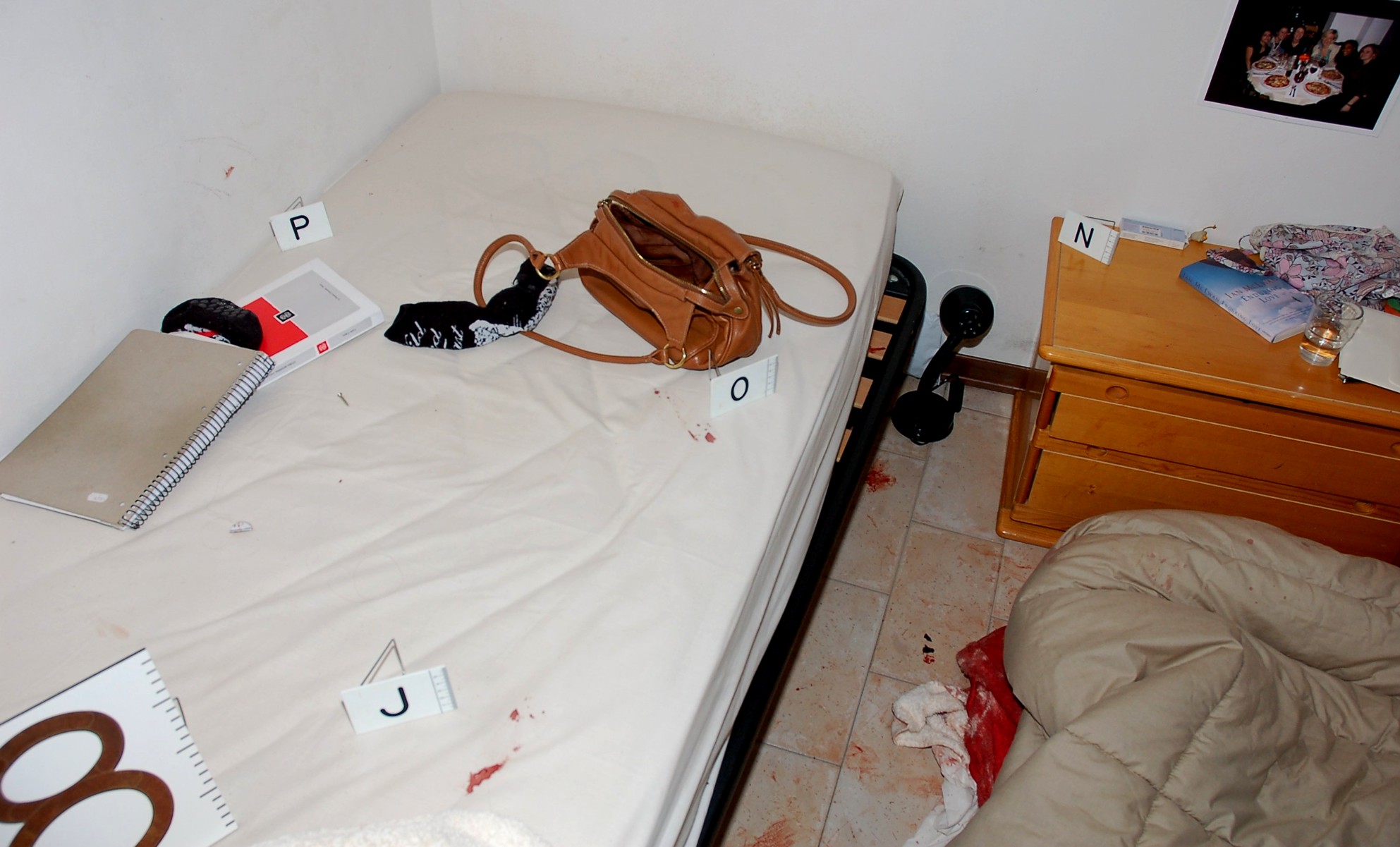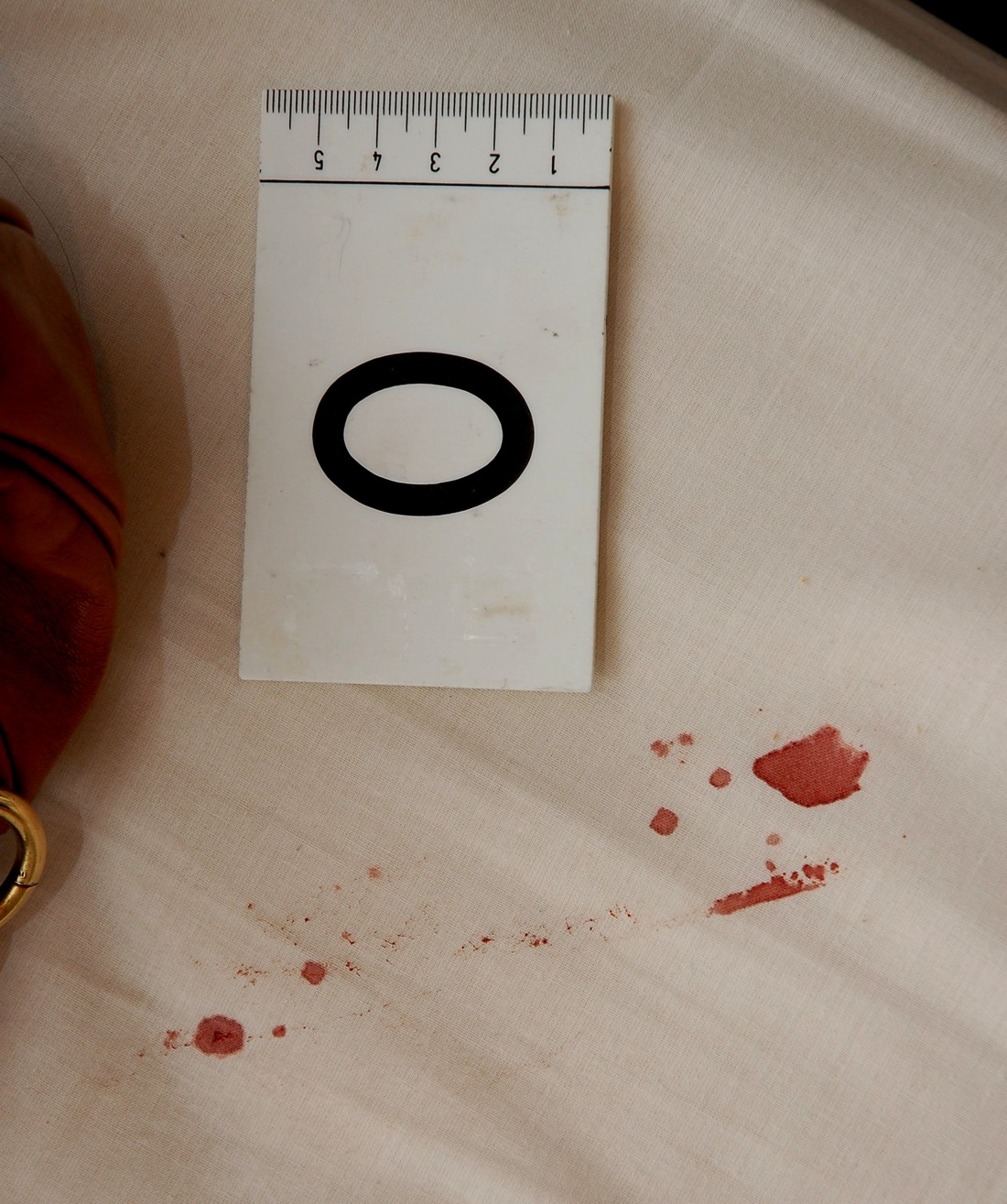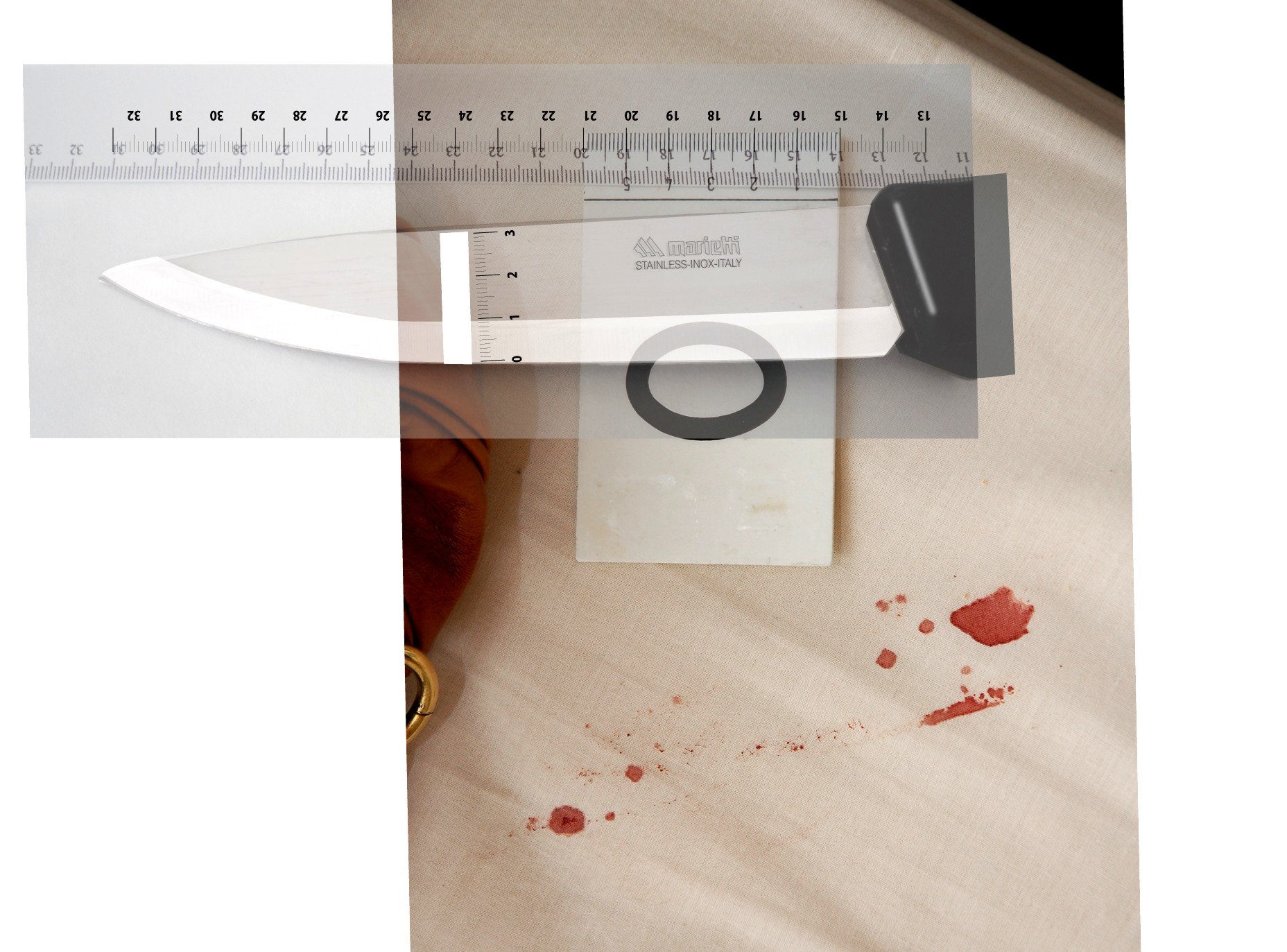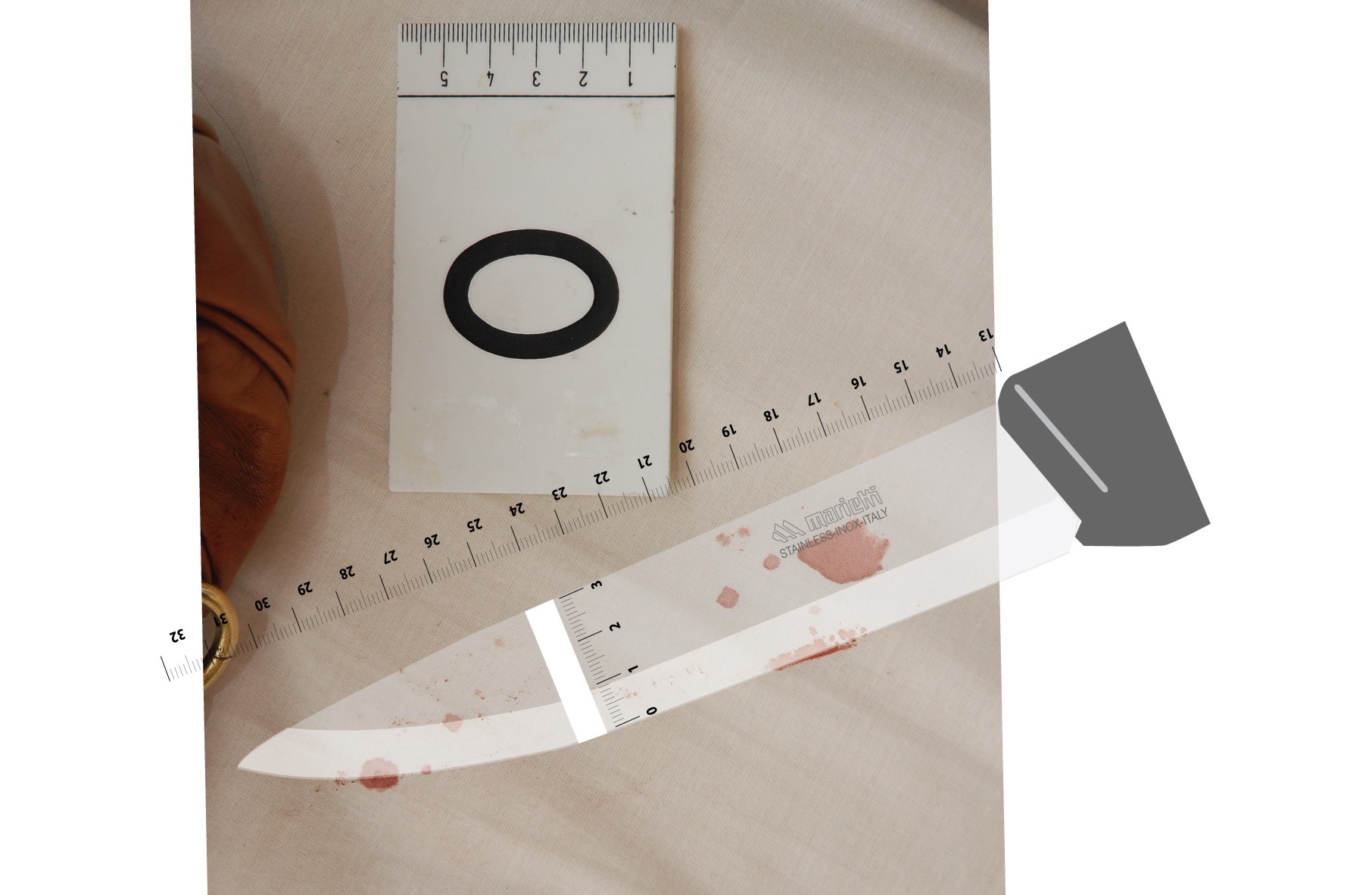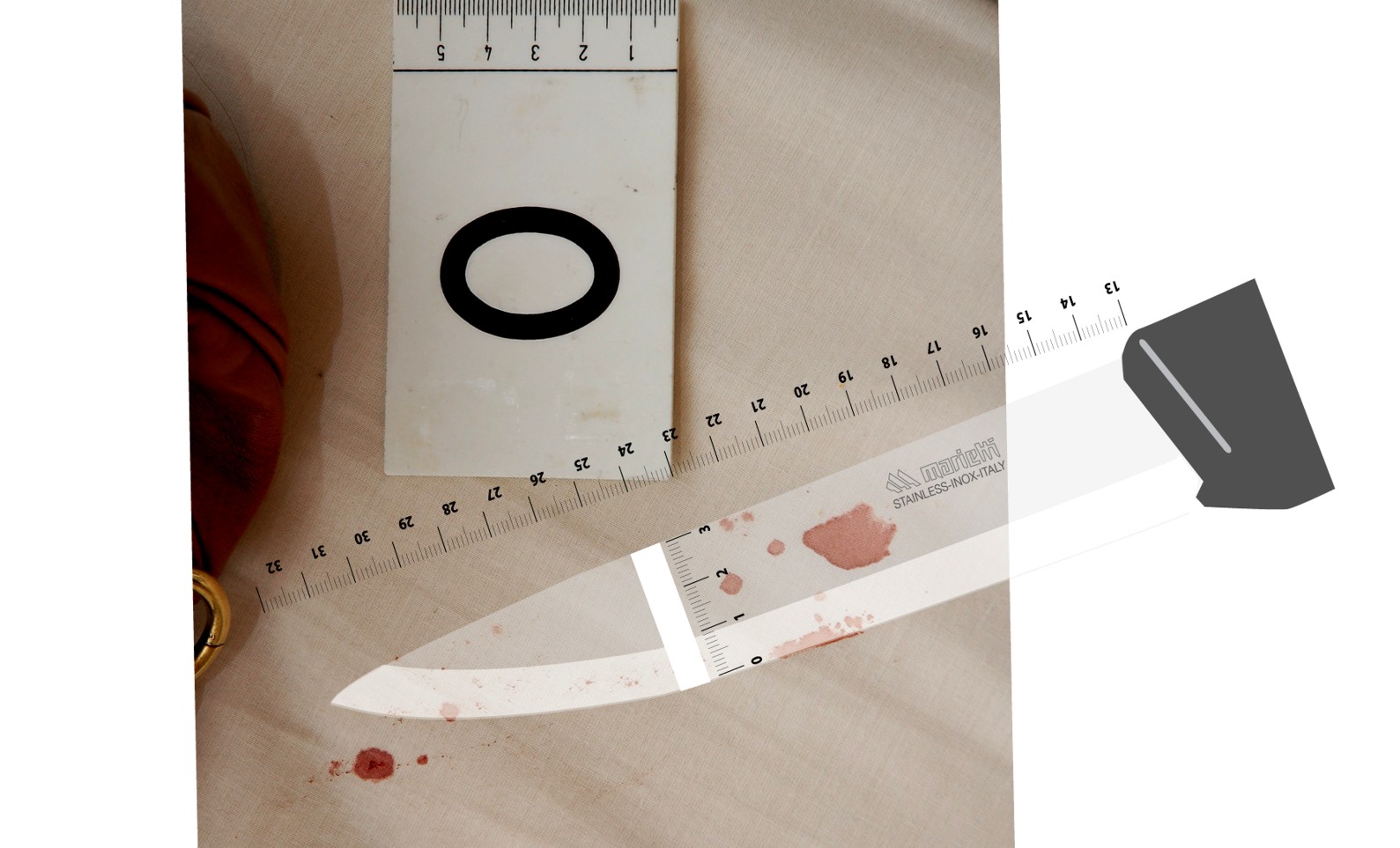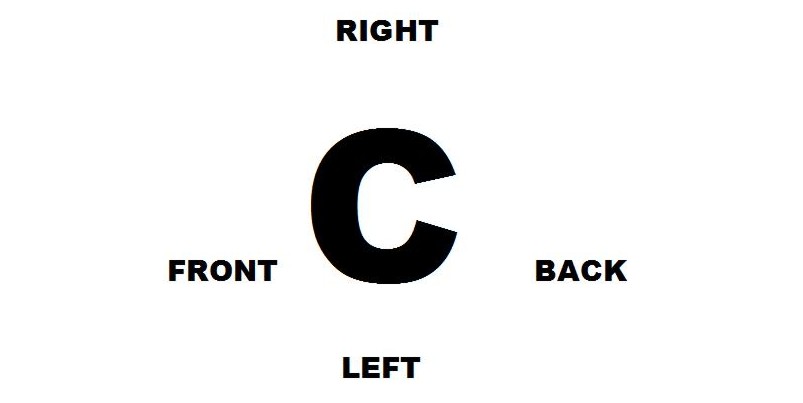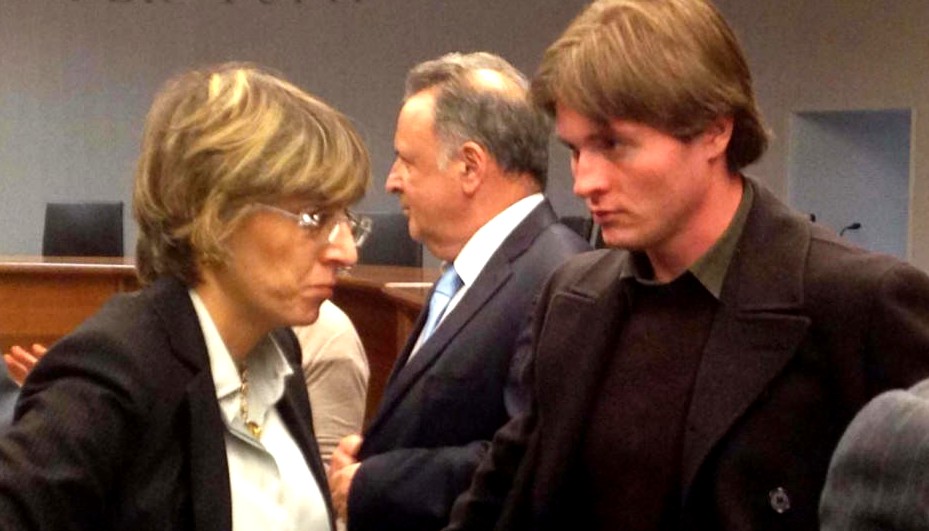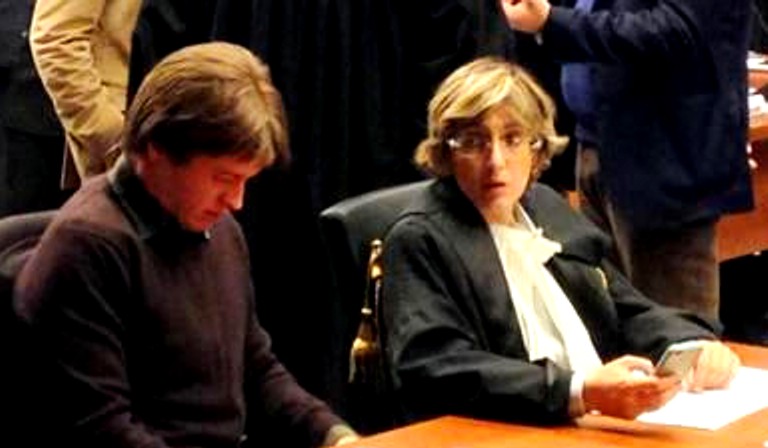
Category: The two knives
Wednesday, October 29, 2014
Analysis #3 Of Testimony Of Dr Chiacchiera, Organized Crime Section: Contradictions Between RS & AK
Posted by Cardiol MD
1. Overview Of This Series
In 2007 Dr Chiacchiera was the Director of the Organized Crime Section and the Deputy Director of the Flying Squad.
He was one of the most senior and experienced law enforcement officers to testify at the trial. His testimony and his cross examination by the defenses occupied a lot of time of the court late in February 2009. He covered the following ground.
(1) He found Knox and Sollecito uncooperative when he asked them questions.
(2) Saw evidence contradicting any lone burglar theory and indicating that the “break-In” to Romanelli’s room was faked.
(3) Phone records and the police investigation into the accused phone activity the night of the murder.
(4) Discovery of pornographic magazines at Sollecito’s house.
(5) Details of how the large knife, Exhibit 36, was collected from Sollecito’s and the evidence that it is the murder knife.
Dr Chiacchiera was submitted to cross-examination on the above 5 items by 4 Attorneys for the Defence of Knox and Sollecito, by 2 Civil Party Attorneys, and to Re-examination by the Prosecution. He had a gruelling time as a witness.
All the translation is by the ever-dedicated main poster ZiaK. This series is highlighting some key portions. Here is the full 50-page transcript which will be posted in the trial testimony area of McCall’s great Wiki.
(GCM=Giancarlo Massei; MC=Manuela Comodi; MaCh=Marco Chiacchiera; GB=Giulia Bongiorno; DD=Donatella Donati; CP=Carlo Pacelli; LG=Luciano Ghirga; CDV=Carlo Dalla Vedova; FM=Francesco Maresca)
Continuation of Dr Chiacchiera’s Evidence-in-Chief:
MaCh: It emerged that normally Sollecito kept his cellphones, and also Amanda Knox, they kept their cellphones on until a late hour, evening, [sic] there is no telephone traffic from 20:40 hours. A thing of this “¦
{Witness begins Testimony re cellphones and is interrupted}
MC: But did this emerge from the declarations or did it emerge from the analysis of the [phone] records in the preceding days?
{Examiner interrupts witness with good Q re source of telephone-usage information}
MaCh: It emerged from the analysis of the [phone] records in the preceding days.
{Witness answers clearly}
GCM: Excuse me. Let me understand. In other words you say: the cellphone was switched off and there was no telephone traffic, these are two different things.
{Court asks good clarifying Q}
MaCh: I’m saying, Mr President. Two things. The first, normally Sollecito’s telephone and the telephone of Amanda, were switched on until the late hours. The fatal evening, they were switched off from 20:42 hours until “¦ one [of the phones] from 20:42 onwards and the other from about 20:50 onwards. One. Two, the traffic “¦
{Witness is Answering Court's Q in 2 parts. When he gets to his part #2, Court interrupts}
GCM: Before going on to “Two”, excuse me: “normally” ““ what does that mean? You had “¦
{Court is asking good Q re witness's Part #1, but is interrupted}
MaCh: We had done a comparative analysis of the telephone traffic of that evening with the telephone traffic of the preceding evenings. Shall we say the habits ...
{Witness interrupts Court with narrative response, and is also interrupted}
GCM: And so the “normally” emerges from this?
{Court interrupts witness's response with good Q}
MC: How many evenings? If you recall, or not?
{Examiner asks witness relevant Q, adding redundant Q}
MaCh: Months, no “¦ honestly, I don’t remember how many [evenings], but months.
{Witness stumbles, seeming uncertain re 'evenings' vs 'months'}
MC: I mean to say, not “¦
{Examiner preambles re her redundant Q but is interrupted}
MaCh: Not three days, no. The telephone traffic habits were evaluated. [This is point] one. [Point] Two, the element that emerged, that contradicted the declarations, I can’t report on the declarations but I can report on the element that contradicted [sic. i.e. provided the contradiction], that in effect no telephone call had arrived at 23:00 hours, as had been declared: on the phone line that was declared to have received that “¦ the recipient of that very phone-call. Another element: no interaction with the computer emerged, unlike what was declared. So there were a few objective elements of comparison from the analysis and from the technical checks that contradicted what had previously been revealed.
{Witness interrupts Examiner with narrative response to Examiner's Q, witness indicating contradiction between suspects' declarations and objective records of telephone and computer activity}
MC: For Amanda Knox, were there incongruities of this type?
{Examiner asks if incongruities/contradictions existed for Amanda Knox}
MaCh: Yes, there were incongruities because Amanda Knox was, how to say, contradicted by Sollectio, and then she contradicted herself, if I may “¦
{Witness answers affirmatively, amplifying applicability both to Sollecito & Knox, but is interrupted}
GB: President, if we continue in this way, then we might as well do the old [trial] procedure.
{Giulia Bongiorno, Sollecito's lawyer interjects, objecting-subjectively to Court, but submitting no legal basis for her objection}
GCM: Excuse me, please.
{Court seems to politely rule GB out-of-order}
MaCh: The elements, these are [sic], Mr President, I don’t know how to do.
{Witness communicates uncertainty to Court}
MC: But it is so difficult, however.
{Examiner chimes-in apparently commiserating with her witness's uncertainty}
MaCh: Mr President, I really don’t know what to do.
{Witness seems to repeat statement addressed to Court, who possibly interrupts}}
GCM: Excuse me”¦
{Court seems to begin response to Witness, but is possibly interrupted}
MaCh: If I have to describe the investigation activity “¦
{Witness may be interrupting Court or is continuing Witness's unfinished statement to Court}
MC: He’s not referring to declarations.
{Examiner chimes-in with his opinion re Witness's reference to Defendants' contradictions/incongruities - GB's interjection seems to have side-tracked court procedure}
GCM: Regarding these declarations, you can report on this [sic. i.e. in this instance?], and with regard to Raffaele Sollecito, you reported ““ citing the telephone traffic and citing the use of the computer. There now, and this is one point. With regard to Amanda Knox, you cannot report the declarations. But you may, however, say ““ following these declarations ““ what type of investigations you carried out, and the outcome of these. So, following the declarations given by Amanda Knox, did you do similar investigations, as [those you did] for Sollecito Raffaele on the [phone] records? Or was there nothing to do, except to “¦?
{Court rules on subject of testimony re Defendants' declarations, seeming to rule admissibility of Sollecito's declarations re telephone traffic and computer usage, but inadmissibility of Knox's declarations. Court does seem to permit description of investigations that followed Knox's declarations, without describing Knox's actual declarations, and Court asks whether phone-record investigations similar to those done for Sollecito were done for Knox.}
MaCh: Mr President, all the necessary checks were made, but in that immediate moment the most important element “¦ that is to say, in [this] place [NdT: i.e. “in this Court”], in this moment, in this place, that is to say, when they were “¦ I said [that] when the arrests were made, I don’t, I don’t know how to do, however, the incongruity of the declarations with the facts that we had found, and with the declarations that Sollecito had previously given us, [this] was the most important element. I don’t know if I have managed to “¦
{Witness seemingly responding to Court that he doesn't know how to deal with the declarations, is interrupted.}
GCM: No, excuse me (overlapping voices). So, with regard to Raffaele Sollecito, we have
understood these checking activities were carried out on the declarations made, the verification activities carried out, and [that’s all] very well. With regard to Amanda Knox, if you also carried out “¦ maybe there were no objective elements for possible checking, there were no “¦ or else, there were activities carried out of “¦
{Court, interrupting over witness's testimony, seems to be explaining his Q to witness, but is interrupted by witness}
MaCh: Later, there emerged a series of further elements.
{Witness interrupts with statement re unspecified further elements}
GCM: Not evaluations on the congruity, incongruity, likelihood, these are evaluations and will be done, there you go, comparably. I’m thinking of the [phone] records, of the use, if she had given indications on the basis of which [you] could carry out investigative activity “¦
{Court seems to want evidence in Knox's phone records justifying further investigation.}
Here ends the Testimony Of Dr Chiacchiera covering the relevant Phone Records, elicited by the Prosecution.
Next comes the Testimony Of Dr Chiacchiera elicited by the Prosecution, covering Discovery of pornographic magazines at Sollecito’s house, Details of how the large knife, Exhibit 36, was collected from Sollecito’s and the evidence that it is the murder knife
Thursday, September 25, 2014
Analysis #2 Of Testimony Of Dr Chiacchiera, Organized Crime Section: Discounting Any Lone Wolf
Posted by Cardiol MD
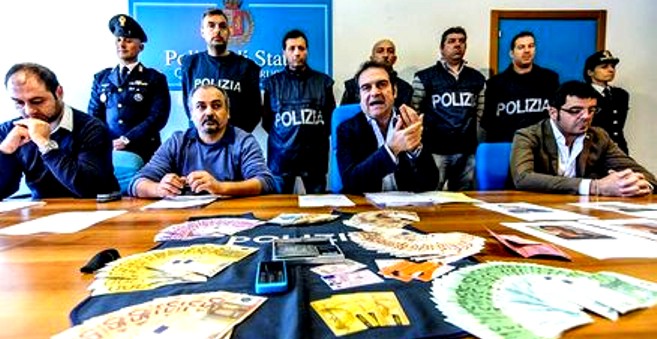
Dr Chiacchiera (talking) with his team explaining reason for charges in another case
Overview Of This Series
In 2007 Dr Chiacchiera was the Director of the Organized Crime Section and the Deputy Director of the Flying Squad.
He was one of the most senior and experienced law enforcement officers to testify at the trial. His testimony and his cross examination by the defenses occupied a lot of time of the court late in February 2009. He covered the following ground.
- (1) He found Knox and Sollecito uncooperative when he asked them questions.
(2) Saw evidence contradicting any lone burglar theory and indicating that the “break-In” to Romanelli’s room was faked.
(3) Phone records and the police investigation into the accused phone activity the night of the murder.
(4) Discovery of pornographic magazines at Sollecito’s house.
(5) Details of how the large knife, Exhibit 36, was collected from Sollecito’s and the evidence that it is the murder knife.
All the translation is by the ever-dedicated main poster ZiaK. This series is highlighting some key portions. Here is the full 50-page transcript which will be posted in the trial testimony area of McCall’s great Wiki.
This post continues analysis of the evidence that the lone burglar/lone wolf theory was not credible to those that were first on the crime scene and that the “break-In” to Filomena Romanelli’s room was to them obviously faked.
(GCM=Giancarlo Massei; MC=Manuela Comodi; MaCh=Marco Chiacchiera; GB=Giulia Bongiorno; DD=Donatella Donati; CP=Carlo Pacelli; LG=Luciano Ghirga; CDV=Carlo Dalla Vedova; FM=Francesco Maresca)
Public Prosecutor Comodi [MC] Leads Testimony
Judge Massei [GCM}: Excuse me a moment, just to give some guidelines, but of the evaluations that the witness is expressing, obviously it’s not that they can be taken account of, however we will acquire them [for the trial files] in order to understand the investigation activities, the appropriateness of the investigations that were carried out, directed in one way or in another, there you go. However, maybe, “¦ there you go, yes, maybe if we can manage to keep with the bare essentials this will help everybody.
{Court proceedings seem to have been diverted into a free-for-all colloquy, with multiple participants chiming-in, and creating confusion. Court-President, GCM, now politely intervenes, apparently trying to restore order, ruling that the professional evaluations made by the witness, testified-to by the witness, should be admitted for the trial files. The appropriateness of the witness's evaluations can be dealt with separately and later.}
Manuela Comodi [MC}: Well, in short, they were called “¦ they are the only ones who can describe the whole progression of the investigations - Dr Profazio and Dr Chiacciera ““ because they are directors, they are the only ones who will come to describe for me, thus, what was the progression of the investigations. Clearly, in order to pass from one investigative act to another rather than “¦ and the choice of the subsequent investigative acts. It’s clear that they have to describe, in order to make a complete reasoning, even the lines of thought that, as Dr Chiacchiera said, it sometimes happens that they make. However, one point: apart from the break-in, apart from the broken window, there are “¦ did you acquire further elements that corroborated the idea that there had been a burglary? Nothing from Romanelli’s room had been carried off? Valuable things had been taken?
{Examiner acknowledges Court's admonition, argues importance of her witness's testimony, and segués into triple-Q addressed to witness re elements corroborating idea of burglary.}
Dr Chiacchiera [MaCh]: This ... in fact, in the progress ...
{Witness begins to answer, but is interrupted by Examiner}
MC: Was a declaration/complaint of theft made then, with a list of the things taken?
{Examiner interrupts witness with new double-Q}
MaCh: In the logical progression, if I may in some way still, in summary, say what “¦.
{Witness begins narrative response but is interrupted by Court}
GCM: Say the objective facts, if you have “¦.
{Court interrupts witness, beginning to admonish him to respond by testifying to objective facts, but is itself interrupted by witness}
MaCh: Nothing disappeared, so a burglar would have had difficulty “¦
{Witness answers 3rd Q of Examiner's above triple Q, but then launches into a narrative beginning: "so…", but Court interrupts}
GCM: Excuse me, nothing had disappeared? Before all else, what thing .... you knew what things were in that room that did not disappear?
{Court interrupts, questioning basis for witness's statement that "Nothing disappeared"}
MaCh: Yes, because, shall we say, the investigation elements that then subsequently emerged, allowed us to deduce that from Romanelli’s room absolutely nothing disappeared. There was a complete mess/chaos, but nothing disappeared from Romanelli’s room. And this is another element to [lead us] to obviously deduce that the desired hypothesis of a burglar and of a theft was objectively “¦ But then the burglar does not [sic] close the door and throw away the key. The burglar does not cover the victim. The burglar “¦
{Witness answers Court's Q, with narrative explanation including reference to "the key", and Court interrupts}
GCM: Excuse me. They key. What is this detail about the key? What is it?
{Court asks Q simple Q re "the key" - with apparent transcriptional error: "They key"}
MaCh: There was no key.
{Witness answers Court's Q}
GCM: There was no key where?
{Court asks simple Q}
MaCh: Those who entered into the inside of the house first found the door closed. A closed door that then aroused the suspicions and that then gave concern and then it was decided to “¦ to break [it] down.
{Witness responds to Court's Q with narrative explanation}
GCM: Excuse me, on [sic] Romanelli’s room there was no key?
{Court asks another simple Q}
MaCh: No, I’m talking of Meredith’s room, Mr President; Meredith’s room was locked by key.
This is another “¦ how to say, the investigative deductions that we drew from these details that emerged, also from the declarations that we gathered.
{Witness responds to Court's Q, and informatively amplifies A}
MC: Was it normal that Meredith closed herself [sic. i.e. her room] by key?
{Examiner asks witness a simple Q}
MaCh: No.
{Witness gives simple A}
MC: And did you find the key of Meredith’s room?
{Examiner asks witness a simple Q}
MaCh: No.
{Witness gives simple A}
MC: So it was closed by key, but there was no key inside?
{Examiner summarises witness's testimony re key and poses a simple Q}
MaCh: But there was no key inside, so that it was necessary to break down the door in order to enter. Also the almost inexplicable detail of the presence of two cellphones in a garden of a house, doesn’t tend to favour the thesis of someone who enters and who accidentally, so to speak, finds a person and then kills them, because [he] is forced to kill them because they have seen [his] face.
{Witness responds to Q in form of confirming-repetition and amplifies A in expanded narrative-form}
MC: But is via Sperandio far from via della Pergola?
{Examiner poses vague Q re proximity of 2 streets}
MaCh: No. And there we tried to deduce. And via Sperandio, as I said earlier, Doctoressa, is not far from the house. We discussed [this] to understand why these telephones went and ended up there “¦
{Witness answers simply, and respectfully, introducing " the house" on one of the streets, seguéing into subject of the mobile telephones and is interrupted by the Court}
GCM: Excuse me. When you say it is not far from the house, can you specify at what distance? How one reaches it?
{The Court's interruption is also vague, with double-Q, referring to an unspecified "it"}
MaCh: Not far from the house means that, by following a route that any Perugian knows, Mr President, one passes through a park and one arrives, let’s say, near the gateway of Porta Sant’Angelo. So for this reason, as the crow flies, how much would it be, but less [sic] “¦ three hundred, four hundred metres. But to reach it by foot from via della Pergola to via Sperandio I think that it doesn’t take more than 5, [or] 7 minutes.
{Witness responds to Court in explanatory narrative form
MC: But do you have to pass by via Garibaldi?
{Examiner asks simple Q}
MaCh: Yes. But you can also pass through the park ““ there’s a park that then comes out right in front.
{Witness answers Q, and amplifies his response}
MC: Of the villa?
{Examiner seeks clarification of witness's response}
MaCh: In front of the villa, at the entry to the villa. Looking from the street that crosses with the provincial [road], the one that, shall we say, borders the villa, whoever is looking at it, I repeat, I ““ who am 44 years old, am Perugian ““ I did not know that there was a garden behind there.
{Witness clarifies his response, amplifying further}
MC: And how far away is via Sperandio from via Garibaldi, corso Garibaldi?
{Examiner asks apparently simple Q}
MaCh: it’s parallel. It’s very close, very very close. It’s 200 metres away, as the crow flies. I think even much less, because they are almost parallel, let’s say. Even that is something that in some way made us understand that there was an interest in getting rid of those cellphones, clearly, by whoever did that thing there.
{Witness gives detailed response;
See: "Just seeing police could panic the killers into instant dumping of the telephones, without even needing to know why the police were where the police were (There is no need to invoke any awareness by the phone-dumper[s] of the reason the Police were near Mrs. Lana's place - the hoax-call.). So if the killers saw flashing police-lights, or any other sign of police near Mrs. Lana's place, that sign could be enough to explain panic phone-dumping - then and there (not considering whether the phones were switched-on or switched-off)." In TJMK: "Updating Our Scenarios And Timelines #2: An Integrated Comparison Of The Timing of the Phone-Events." 6/28/2013}
MC: When you arrived for the first time in via della Pergola, did you enter the room of the crime?
{Examiner asks simple Q}
MaCh: Immediately, no. I went in afterwards, when Dr Mignini also arrived; and later with Dr Lalli. Then I had, how to say, occasionally entered when the crime-scene inspection of the Forensic Police, of the colleagues arrived from Rome, was already begun, so late. I didn’t stop long inside the house, I say the truth, also because the measures/orders that I issued immediately were those, yes, of deducing, [of] drawing out all the investigative elements that might emerge in the immediate surroundings [and/or immediately after the facts] to seek to immediately direct the investigation activity, but also to “freeze” [sic. i.e. to solidify, or to make concrete] another aspect, which was that of hearing/questioning all the people who might tell us details on Meredith’s stay in Perugia, in general, but above all on her final hours, on her visits/visitors, everything about those who Meredith had known in some way and “¦ This was the thing that we considered logical to do precisely in relation to this, to these first investigative deductions that we drew from the [above]-described crime-scene.
{Witness gives detailed narrative reply}
MC: And so that same day you were present when they began to hear/question…
{Examiner begins preamble to presumed Q, but is interrupted}
MaCh: Yes.
{Witness interrupts Examiner with witness's answer to assumed Q}
MC: “¦ the people [who were] acquainted with the facts.
{Examiner completes interrupted Q-in-the-form-of-a-statement, which omits Q-mark}
MaCh: I was present. I did not participate personally in the examination [of witnesses], but I was present, in the sense that both with [my] colleague Profazio and with [my] other colleague from the central operative service”¦
{Witness responds with narrative description of circumstances, but is interrupted}
MC: from Rome.
{Examiner interrupts with her assumed next part of witness's response}
MaCh: from Rome. We began to put the pieces together, excuse my [use of] the expression; that is to say all the “¦ all the elements that emerged from the examination of witnesses, were checked, were gradually verified/cross-checked. Both with cross-checks that enlarged the group of witnesses, of the people to be heard/questioned, and with the checking of the alibis of many people, [as well as] with a technical activity that was carried out.
{Witness confirms Examiner's assumption, and completes his narrative description of circumstances}
MC: That is to say?
{Examiner enquires as to witness's reference to indefinite "technical activity"}
MaCh: A technical activity. A bugging activity was carried out. There was also an activity carried out also for the cross-checking of the phone [activity] printouts. There was an activity to understand also the cross-checking of the [phone] cells. There was a very wide-range activity carried out. Without excluding, I repeat, all also [sic] ... shall we say, the minor hypotheses. For example, the news arrived of a Maghrebi who had been in a rush to wash his own clothes in a launderette, not too far from the scene of the crime. This piece of information was excluded for a very simple reason, because from the first results of the investigative inquiries, he had arrived there in the early afternoon, but instead, in the early afternoon of the day before her death, Meredith was still alive [sic]. Because from the witness examinations we had determined that the last person who had seen her alive, saw her in the late afternoon. After which, we also did another series of checks relative to the one [sic] that there was a strange telephone call that the people who found the cellphones in the famous villa, the beautiful one on via Sperandio, had received in the evening. However, we had, how to say, understood that it was a case of a boy who had made a call from Terni and of a strange coincidence, but absolutely irrelevant for the investigation activity. Indeed, we made checks on all the hospitals in order to evaluate, to check, whether maybe there were [patients] who had presented blade/cutting wounds that in some way might have been compatible with a wound, let’s say, or at any rate with a reaction by the victim. Only one had presented, it was a [person] from Foligno who, [while] cutting salami, had cut their hand during the trip back from an away-game with Foligno ““ he was a football fan. Nothing else. So no investigative hypothesis was rejected. It was, obviously, because this is how it is done, and thus I believe that it is logic, we began to discuss/think in a certain way, because we had deduced from all this scen, another series of further elements, that is to say that the person “¦.
{Witness responds with prolonged narrative re "technical activity" and seems to pause}
MC: Speak. Don’t be afraid to say it.
{Examiner urges witness to continue}
MaCh: No, no. I’m not afraid.
{Witness argues with Examiner}
MC: That is, let’s say, when was it that the investigations turned to, [started] to focus on today’s defendants?
{Examiner asks simple Q}
MaCh: When on the evening of “¦ they did not focus on today’s defendants, that is to say, progressively the analysis of the investigative elements made us “¦ made us start, even us, to suspect. Because going into a house, finding a [sic] door of Meredith’s room closed, a [sic] door of the apartment opened, faeces in the toilet [bowl], while I take a shower, a series of bloody prints”¦
{Witness responds in narrative form and is interrupted}
MC: However the faeces were in which of the two bathrooms?
{Examiner interrupts witness with clarifying Q}
MaCh: Of the bathrooms. Me, if I take a shower in a bathroom where there are faeces, instinctively I flush the toilet, in short.
{Witness makes non-responsive subjective statement and is interrupted}
MC: Yes, but the faeces were in the other bathroom.
{Examiner engages witness in argument}
MaCh: Yes, yes, I understood. However, in short, in some way it comes instinctively, no?, to flush the toilet? The fact is that “¦.
{Witness joins argument and is interrupted}
GCM: Excuse me, do you know how many bathrooms there were in the house?
{Court interrupts argument with simple Q}
MaCh: Two.
{Witness ignores actual Q and responds with answer to assumed follow-up Q}
GCM: Two bathrooms. Excuse me, please. Do you know that a shower was taken?
{Court asks another simple Q, using vernacular ref. to whether a person used the shower, rather than that the the shower device was taken away.}
MaCh: Yes.
{Witness answers Court's actual Q}
GCM: How do you know?
{Court asks simple follow-on Q}
MaCh: I know because it is a thing that I cannot, I believe, report because it was “¦.
{Witness seems to answer in non-responsive, subjective narrative form, and is interrupted}
GCM: But you checked”¦?
{Court seeks objective answer to his simple Q}
MaCh: I am trying to be very very careful.
{Witness hints that he has reasons for apparent evasion}
Giulia Bongiorno [GB]: Mr President, we are talking of nothing.
{Sollecito's lawyer chimes in with distracting comment}
GCM: Excuse me, Attorney.
{Court appears to admonish GCM not to chime-in without specified legal-objection}
MaCh: Well, the main point [is] that very slowly we began to understand that there were strong inconsistencies in the revelations that were made. And there were behaviours that on the part of above all, indeed exclusively, of Sollecito and Knox, appeared to us as [being], at the very least, particular. Behaviours both immediately after the event ““ a sort of impatience/irritability shown [with regard to] the investigation activity that we were carrying out, and obviously we could not but ask [NdT: i.e. “we had to ask”] those who were close to Meredith [about] elements that we considered useful, even necessary, in order to continue the investigation activity.
{Witness launches into apparent justification for his evasiveness}
MC: Excuse me if I interrupt you. I’ll just make a few precise questions, thus: you checked, let’s say, let’s call them alibis, even if it’s a term that’s very so [sic] from American TV films, but in any case [it’s] understandable”¦ Did you check the alibis of the people closest, let’s say, to Meredith?
{Examiner, after preamble, asks relatively simple Q}
MaCh: Yes.
{Witness answers Q as phrased}
MC: In particular, did you check the alibis of the young men from the [apartment on] the floor below?
{Examiner asks simple Q}
MaCh: Yes.
{Witness answers Q as phrased}
MC: Results?
{Examiner poses Q in casual form}
MaCh: Positive for them, in the sense that they were at home, in their own home, that is to say their respective houses, because they were here for reasons of study, so they were not present in Perugia during the days when “¦
{Witness responds with allusive casual A, begins to amplify, but is interrupted}
MC: Because they had left for “¦
{Examiner interrupts with suggestion for next part of witness's response}
MaCh: Yes, for the All Souls’ Day long-weekend, let’s call it that.
{Withess reacts to Examiner's suggestion by stating reason for upcoming week-end absence, but not stating week-end destination}
MC: Did you check the alibi of Mezzetti and of Romanelli?
{Examiner asks double Q}
MaCh: Yes.
{Witness answers for both Qs}
MC: Results?
{Examiner poses Q in casual form}
MaCh: The result in this case also [is that] Mezzetti and Romanelli were not there, so “¦
{Witness gives clear Answer, apparently begins explanation, but is interrupted}
GCM: Excuse me, can you say what checks you did?
{Court interrupts witness's testimony to ask Q re witness's method}
MaCh: We carried out a whole series of checks that brought us to evaluate, establish, that these persons were not present in the premises that evening.
{Witness ignores Court's Q as phrased and answers anticipated next Q}
MC: Let’s say, I imagine that you heard/questioned them.
{Examiner makes statement-in-form-of-Q with ?-mark omitted}
MaCh: Yes.
{Witness answers presumed Q}
MC: Did they tell you where they were that evening, what they did that evening”¦?
{Examiner seems to interrupt and asks double-Q}
MaCh: And in effect, we assessed/considered that “¦
{Witness ignores Q-as-phrased and is apparently interrupted}
MC: And you ascertained that in effect “¦
{Examiner apparently interrupts A and continues his interrupted multiple Q}
MaCh: That it was true what they had told us. I can report on the circumstance.
{Witness seems to continue his interrupted answer and offers to expand his narrative.
Q &A cycle is confused and confusing because of repeated multiple Qs, instead of orderly single Q & A}
MC: Did you check the alibi of Amanda Knox and of Raffaele Sollecito? Was there a comparison between the declarations of Amanda Knox and of Raffaele Sollecito with regard to the night of the murder, and what you were able to compare, shall we say, objectively, through the other declarations, through the phone records?
{Examiner asks multiple Qs}
MaCh: Through the phone records and through the checks [that were], shall we say, objective, it was found that what Sollecito had declared was not truthful because there was a phone call that was never received [i.e. answered] by Sollecito at 23:00 hours. Because it turned out that there was no interaction with the computer, but I believe that this “¦ as declared [sic]. But above all there was an absolute incongruity of the “¦.
{Witness summarizing findings wrt phone records, is interrupted}
GCM: There now. Excuse me. Maybe we will not ask the question in these terms: following the declarations, on which you cannot report, that you got from and that were given by Amanda Knox and Sollecito Raffaele, what type of investigations you carried out”¦
{Court interrupts to restrict Qs but is interrupted}
MaCh: We carried out ...
{Witness interrupts Court's interruption and is interrupted}
GCM: ... and the outcome of these investigations. There now. This is where we’re at.
{Court completes it's interruption, seeming to believe he has made himself clear, but confusion still reigns}
MaCh: Well, in summary ...
{Witness begins a summary, but is interrupted}
GCM: Following the declarations given by them, you had “¦ With regard to Sollecito Raffaele, what did you do and what [information] emerged?
{Court interrupts witness with double-Q}
MaCh: It emerged that, unlike “¦
{Witness begins to answer Court's 2nd Q, but Court interrupts}
GCM: What did you do, first?
{Court repeats1st Q}
MaCh: We did an analysis of the telephone traffic, and from the analysis of the telephone traffic it emerged that Sollecito had absolutely not received/answered the 23:00 hours phone call as he had declared. From the analysis of the telephone traffic, there then emerged a very strange detail, in the sense that the cellphones “¦
{Witness answers 1st Q, begins answering 2nd Q, and is interrupted by Sollecito's lawyer}
GB: (overlapping voices) “¦ continue with the opinions/judgements, with all the opinions/judgements.
{Sollecito's lawyer seems to demand comprehensive testimony}
GCM: That which emerged.
{Court makes seemingly cryptic statement which is probably a Q relating to witness's interrupted A to Court's 2nd Q above: "It emerged that, unlike "¦" }
MaCh: A detail/particular emerged ... unlike what “¦. (overlapped voices).
{Witness resumes testimony but is interrupted, multiple voices are heard}
GCM: Excuse me. What emerged?
{Court asks witness to clarify what witness was saying}
_____________________________________________
Here ends the Analysis of the Evidence #2, discussing that the lone burglar theory is not credible, and that “Break-In” to Romanelli’s room was faked.
The next Post: Analysis of the Evidence #3, will Analyse the Phone records and the police investigation into the accused phone activity the night of the murder.
Tuesday, April 29, 2014
Why Final RS & AK Appeal Against Guilty Verdict May Fail: Multiple Wounds = Multiple Attackers
Posted by Our Main Posters
Reports From Italy On Why AK & RS Appeal Failed
The Nencini Report has been released and we are seeing to its translation right now.
Meanwhile journalists in Italy have these reports which convey the very implacable, damning tone. There was nothing accidental about Meredith’s death; Knox premeditated it all along.
First report
From Il Messagero kindly translated by Miriam:.
FLORENCE - The knife that was seized at Raffaele Sollecito house is the knife that killed Meredith Kercher, and the blow was delivered by Amanda Knox. So writes the President of the Court of Appeal of Florence, Alessandro Nencini, in the motivation report of the sentence that was passed on Jan. 30th that saw Amanda Knox sentenced to 28 and a half years and Raffaele Sollecito to 25 years.
Over 330 pages in which the court covers the appeal and explains the conviction. Starting with the knife considered “not incompatible with the wound that was carried out on Meredith Kercher. “In the present case, writes Nencini what counts is the accessibility of the weapon by the accused, it’s concrete portability from house to house, it’s compatibility with the wound, and the presence of Meredith’s DNA on the blade. All of these elements ascertained by the court lead to the conclusion that the knifed evidenced as no. 36 was one of the knifes used in the attack, and was the knife that Knox used to strike the fatal blow to Meredith’s throat.”
The court retains to have sufficient evidence of “certain reliability” of Rudy Guede (convicted to 16 years) Amanda and Raffaele in the house where Mez was killed, on the night between the 1st and November 2, 2007 in 7 Via della Pergola “in the immediate phases following the murder.” The Court then tells how she was immobilized and Mez “was not able to put up some valid resistance because she was dominated by multiple assailants and cut at the same time with the blades of several knives.”
Rejected therefore is the defense’s strategy of both of the convicted, that have always maintained that the killer was only one.: the Ivorian Rudy Guede.
Second report
Bullet points from various Italian media.
- The big knife from Sollecito’s house held by Amanda Knox caused the fatal wound to Meredith while the other was held by Raffaele Sollecito.
- There is strong “multiple and consistent” evidence of all three in the house immediately following the murder. All three worked to suppress Meredith.
- There was an escalating quarrel between Knox and Meredith leading to a progressive aggression and murder with sexual components.
- Between Amanda and Meredith there was no mutual sympathy and Meredith harbored serious reservations about the behavior of AK.
- The biological trace found on the bra clasp that Meredith Kercher was wearing the night she was murdered was left by Raffaele Sollecito
Third report
No especially accurate reports in English have appeared yet and the erroneous “new trial” is still surfacing. Andrea Vogt tweets that she will be posting an analysis soon.
The mischievous defense-inspired “sex game gone wrong” and “satanic theory” mantras are still widely showing up in the duped media, but are nailed hopefully finally in this new report.
Judge Nencini has closely followed and endorsed the “from all angles” Massei trial analysis, but with the inclusion of some more credible explanations from Prosecutor Crini which Judge Micheli had also espoused back in 2008.
In particular, Rudy Guede is not now highly improbably seen as the one initiating the attack on Meredith, and sex was not at all the primary driving force for the attack (the prosecution never ever said it was). Knox carried the big knife from Sollecito’s for a purpose.
The bad blood between the girls resulting from Knox’s crude, brash, very lazy, drug-oriented behavior was well known in Meredith’s circle. All of them had backed away from her, as also had her employer and the patrons in his bar.
There was a probable theft of money by Knox who was unable to account for a sum similar to what Meredith would have stashed away for the rent and that is seen as the probable spark for the explosive argument and attack.
Fourth report
Barbie Nadeau in The Daily Beast
Amanda Knox apparently did not kill Meredith Kercher in a “sex game gone wrong,” as had been previously decided by a lower court in Perugia, according to a Florentine appellate judge who released today a 337-page document explaining his decision to convict Knox and her erstwhile Italian boyfriend, Raffaele Sollecito, for Kercher’s murder. Rather, the judge claims, Knox allegedly killed Kercher, her 21-year-old British roommate, because she didn’t like her.
All Italian courts require judges to explain the reasoning behind their rulings, and it likely represents the penultimate step in a seven-year case that has seen Knox and Sollecito first convicted in 2009 then acquitted in 2011 then convicted again in January 2014. Rudy Guede, an Ivory Coast native who was also convicted for his role in the murder back in 2008, is serving a 16-year jail sentence. He is currently eligible to apply for work furloughs from prison.
Judge Alessandro Nencini, along with a second judge and six lay jurors, were tasked with hearing a second appeal that began in September 2013 after Italy’s high court threw out the acquittal that set Knox and Sollecito free in 2011. Italy’s high court cited “inconsistencies” and “legal mistakes” and tasked Nencini’s court with hearing the appeal again. It was not a retrial per se, but rather a fresh look at the appeal process that freed Knox.
Nencini decided that the appellate court that set Knox free erred in evidentiary and legal matters. That court will now have to rule definitively on the case, using Nencini’s reasoning and whatever appeal Knox and Sollecito file for their final judgment. If the high court accepts Nencini’s verdicts, the two will be required to serve their prison sentences in Italy. Knox has vowed she will not return to Europe, but Sollecito, unless he escapes, won’t be as lucky.
The court’s explanation of its decision comes down hard on the first appellate court that overturned Knox’s guilty verdict, at times seemingly scolding them for misapplication of penal codes and for throwing out witness testimony without explanation. “It was an operation of evaluating evidence with using logic,” Nencini wrote, accusing the first appellate court of essentially throwing out testimony that allegedly proved Knox’s involvement, but keeping testimony that supposedly supported her innocence.
He used Knox’s prison diary as a prime example. “Look at the contradictions in the evaluation of the diary written in English by Amanda Knox,” he wrote, referring to a handwritten prison diary taken fromKnox’s cell as part of the investigation to determine why she accused her pub boss Patrick Lumumba of Kercher’s murder during early interrogations. “On one hand, the appellate court of Perugia completely devalued the writings when she admitted wrongdoing by accusing Patrick Lumumba. On the other side, they valued it when she defended herself.”
Nencini also ruled that there was plenty of forensic evidence tying Knox and Sollecito to the crime scene, writing “they left their tracks in the victim’s blood” more than once in the document. He accepted testimony that supported the theory that a knife found in Sollecito’s apartment was one of the primary murder weapons, and he reasoned that a second knife was also used that matched a blood stain left on Kercher’s mattress.
The first knife in question was the only hard evidence reexamined in the second appeal, and forensic experts ruled that a previously untested spot on the knife’s handle consisted of 100 percent Knox’s DNA. An earlier court heard testimony that a tiny smidgeon of DNA on the groove of the blade was Kercher’s, but the first appellate court agreed with witnesses who testified that the sample was too small to be considered a perfect match. The second appellate court not only considered the knife to be the murder weapon, it also ruled that Knox “plunged the knife into the left side of Kercher’s neck, causing the fatal wound.”
The second appellate court also reasoned that Kercher’s bra clasp, which had been cut from her body after she was killed, had Sollecito’s DNA on the tiny metal clasp. “The biological trace found on the bra clasp that Meredith Kercher was wearing when she was assassinated belonged to RaffaeleSollecito,” Nencini wrote, agreeing with the judge in the original murder conviction. “The clasp was manipulated by the accused on the night of the murder.”
The court also scoffed at certain rulings laid out by the first appellate court, saying that the court’s reasoning that it would have been easy for “a young athlete” like Rudy Guede to scale the wall and enter the apartment, was borderline racist.
Nencini also ruled that with regard to motive in the murder, it was subjective and personal. “It is not necessary for all the assailants to share the same motive.”
The court picked out small details of Knox’s presumably errant testimony, including how she told police the morning Kercher’s body was found that Kercher always locked her door “even when she takes a shower,” which was later contested by the girls’ other roommates.
Nencini also clearly believed ample forensic testimony, presented by experts examining the original autopsy, that Kercher was killed by more than one person. “”She was completely immobilized when she was murdered,” he said, reasoning that Guede could not have acted alone, and instead likely held her back as Sollecito and Knox knifed her.
The judge also pointed out incongruences in Knox’s testimony about the night of the murder, but noted problems with the other witnesses, which included a homeless man, an elderly woman who said she heard screams. Still, he ruled that Knox’s accusation of Lumumba is vital evidence against her. “It is impossible to separate the two acts,” he wrote.
Using Nencini’s reasoning, Knox’s lawyers now have the roadmap for planning their final appeal to Italy’s high court, likely later this year or in early 2015. However, this same high court threw out the acquittal in the first place, so Knox may need more than luck to walk free. If she is definitively convicted, she will likely face an extradition order to come back to Italy to serve out her sentence. There are very few legal loopholes that would allow an American citizen to escape a court decision by a country, like Italy, that shares extradition treaties with the U.S.
[Judge Massei at crime scene; report says why Knox & Sollecito appeal against his 2009 verdict has failed]
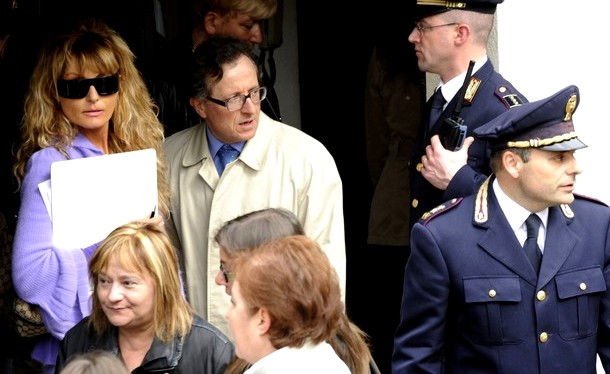
[The Supreme Court in Rome is expected later this year to confirm this outcome]
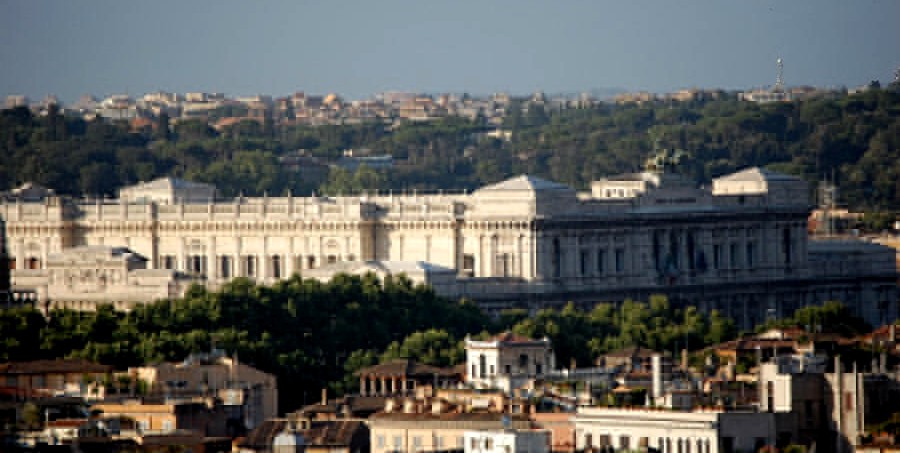
Monday, February 03, 2014
Authors Of “Math On Trial” Bring The Explanations Of The Hard DNA Evidence Up To Date
Posted by Peter Quennell
The important new book in question Math On Trial is by mathematicians Leila Schneps and Coralie Colmez who is Leila’s daughter.
This article by Leila Schneps appeared in yesterday’s edition of The Independent and explains why the Nencini court has not ruled out any of the DNA evidence.
It’s not right to say there is “˜no evidence’ in the case against Amanda Knox. There’s plenty
The DNA alone is enough to raise questions
The verdict handed down yesterday at the new appeal trial for Amanda Knox and her former Italian boyfriend, Raffaele Sollecito, accused of the murder of British citizen Meredith Kercher in Italy in November 2007, may come as a surprise to those whose view of the case has been affected by an international media blitz based on the oft-repeated claim “There is no evidence”. Many believe that Rudy Guede, convicted in October 2008 for participating in the murder, acted alone.
There is, however, copious evidence to consider: the DNA alone is enough to raise questions. Leaving aside much of it, let’s focus for a moment on three key pieces of DNA evidence and present them from both sides, just as the jury may have heard them spoken of in court.First ““ the bra clasp.
The part of the victim’s bra containing the hooks had been ripped or slashed from the rest of her bra. Not immediately collected on that first day after the murder, it remained in the room in a sealed house for six weeks before being sent to the lab in December. There, it was tested and found to contain a large sample of Meredith’s DNA, together with a smaller but clearly visible contribution from Sollecito. The defence objections: firstly, between the two searches, objects in the crime room had been moved around, and indeed the bra clasp was found about a metre away from its original position.
Secondly, apart from “˜alleles’ - genetic traces - of Meredith and Sollecito on the clasp, there were a few unidentifiable extra ones. Putting these two facts together, the defence pointed out that Sollecito’s DNA on the bra clasp could have been a consequence of a careless police technician stepping on Sollecito’s DNA elsewhere in the flat and then entering the room and stepping on the bra clasp, even though no DNA of Sollecito was found anywhere else in the house except on a single cigarette butt in the ashtray.
Second ““ the mixed stain.
Although not visible to the naked eye, the chemical Luminol which flashes blue on contact with blood revealed a spot in the room of the flatmate whose window had been smashed and room rifled. Swabbing the spot produced a mixture of Amanda and Meredith’s DNA. This is a clear proof that the murderer entered that bedroom after the murder, as someone must have brought Meredith’s blood into the room, contradicting the defence theory that Rudy Guede broke into the house and then committed the murder.
The usual defence explanation for mixed DNA stains in the bathroom and corridor, namely that the house would have been coated in Amanda’s DNA given that she lived there, does not necessarily apply to a flatmate’s bedroom. It is much harder to leave traces of DNA than is commonly conceived, and hardly any of Amanda’s DNA was found in her own room - where she surely spent a lot more time than in her flatmate’s.
Lastly ““ the knife.
Days after the murder, a large kitchen knife was seized in Raffaele’s flat, where Meredith had never set foot. Police geneticist, Patrizia Stefanoni, swabbed spots on the blade of the knife and on the handle in the knife’s first DNA Test. One spot in particular attracted her attention: a visible scratch on the flat of the blade. The swab taken from this scratch yielded a positive ID for Meredith Kercher.
By the third trial, when a new attempt was made to collect DNA from the knife (which had been swabbed again during the appeal trial, though no tests were then conducted) there was no match to Meredith ““ a result welcomed by Knox’s defence team, though it did not in fact impact on the findings of the first trial.
Stefanoni’s test ““ she only conducted the first - came under strong fire in the courtroom. Two independent expert witnesses called in for the appeal against Knox and Sollecito’s original 2009 conviction stated that she had not worked in conformity with standard international protocol. Indeed, standard protocol for DNA testing involves three steps: first determining how much DNA is in a sample, secondly amplification, which reproduces the sample millions of times, and thirdly electrophoresis which produces the familiar DNA graphs showing peaks in the location of an individual’s alleles. Under cross-examination, Stefanoni explained that quantification had given a result of “too low” as the machine she used that day was not the most sensitive one in the lab.
Knowing that samples undetectable by the machine can still be sufficient to yield positive results, she chose to continue with testing. At the second stage of testing, amplification, a sample will normally be split into two or more pieces in order to run independent tests. But knowing that the sample was small, Stefanoni feared that cutting it in two would yield no result at all, and chose to amplify the entire sample in one unrepeatable test. The end result was a perfect match to Meredith Kercher.
Knox’s supporters have claimed since the beginning that the accusations levied against her are based on the Italian justice system’s hatred of a pretty, American girl who likes parties and having sex. And whilst both parties protest their innocence , Thursday’s decision shows that there is real evidence against her and Sollecito, that cannot be ignored.
Wednesday, January 29, 2014
Continuing Enormous Strength Of The Evidence Which Defenses Seem To Have Abysmally Failed To Shake
Posted by Our Main Posters

[Above Judge Massei at Meredith’s house with panel-of-judges members early 2009]
What this Florence appeal is REALLY about
There is much confusion on this, sowed by various at-distance commentators who don’t read the Italian press or the excellent English-language reporters right there on the spot.
This is NOT a re-trial. This is a FIRST appeal by Sollecito and Knox against the guilty verdicts and sentences Judge Massei awarded them late in 2009. It is being repeated since their defense teams helped to bend the first (Hellmann court) iteration of the first appeal two years ago.
Since the end of 2009 they have been provisionally guilty of murder and other crimes, subject to final ratification by the Supreme Court, which has not yet occurred. Judge Hellmann decided to let them out and travel worldwide. Many think his decision on this was legally weak.
Was there prime-face justification for this appeal?
Under US and UK law many lawyers and judges think the judicial process could have stopped right there in the US and UK, because the grounds for appeal the defenses came up with in 2010 were essentially innuendo about DNA and little else.
But the pro-defendant Italian system unlike almost any other in the world allows appeals if any are filed to automatically go forward. So the bent, stretched-out and illegally wide-scope Hellmann appeal of 2011 was the first result.
Appointed apparently in illegal circumstances to replace the highly-qualified Judge Chiari (the lead-judge for criminal appeals, who then resigned) Judge Hellmann was ill-qualified at best - he was not a criminal judge and had handled only one other murder trial before, which he got wrong.
The annulment of the first first-appeal
The Supreme Court very rarely completely annuls any trial or appeal. But in this case in March 2013 it did just that, on a large number of grounds.
The 2013-2014 Nencini appeal court in Florence starts with the early-2010 Massei report plus new guidelines from the Supreme Court. Nothing else floated since early 2010 counts.
This case seems to break all records ever for (1) defamatory and dishonest PR; (2) dirty tricks, many illegal, by the defense; (3) dishonesty by those accused in two defamatory books and multiple statements to the press; and (4) greed and blood money while the process still goes on.
Contempt of court trials and investigations have commenced to push back, Amanda Knox is particularly at risk because her book contains false accusations of crimes (again) and she defies the Supreme Court in not paying Mr Lumumba his damages though she destroyed his business.
Suggested Reading: Part One
Sooner or later (no necessarily now) read all the must-read posts in this group here, all the open questions for Sollecito in this group here, and all the open questions for Amanda Knox in this group here.
1. Getting up to speed on the 2008 RS and AK charges
Our four-part summary of Judge Micheli’s report is the best thing to read (scroll down) especially Micheli’s argument that ONLY Knox had any reason to re-arrange the crime scene - she lived there and needed to point evidence away from herself.
Also read Amanda Knox’s and Raffaele Sollecito’s many mutually contradictory attempts to provide one alibi for both.
2. Getting up to speed on the 2009 RS and AK trial
The prosecution performed brilliantly and left the defenses despondent and out-classed (paving the way for more dirty tricks in 2010-13) and we were told that two defense lawyers nearly walked off.
To get a flavor of how badly the defenses did, read this post and this post on Knox’s absolutely disastrous stint on the stand. From there the defense portion of the trial really went downhill.
To get a flavor of how well the prosecution did read about the damning reconstruction (known about in all of Italy but not widely elsewhere) described here and here.
3. Getting up to speed on the Massei 2010 Report
The most vital read of all is the short-form version of the Massei Report by Skeptical Bystander and a team on PMF dot Org. If you have no time to read any posts, make sure to read that.
The other vital reads, not here but on the new “The Murder Of Meredith Kercher Wiki”, are the overview of the evidence and the chart of evidence synopsis.
We had a large number of posts starting in 2010 checking out whether in all details the Massei Report got it right. Read this first take.
4. Getting up to speed on the crime-scene scenario
Vital to understanding the Massei court’s crime-scene scenario which Prosecutor Crini espouses, wade through this excellent reconstruction of the crime in a long Powerpoint by our lawyer James Raper with the Powerpoint whizz Kermit.
About Part Two
The next part of our most-recommended reading from 2010 to 2014 will follow after the verdict to help correct the ill-informed debate over whether Knox goes back to jail.
It hardens the case and in our view leaves no holes for RS and AK to wiggle through. We will point the post to those arguments that anyone tries to raise.
Tuesday, January 28, 2014
Strong Proof That Raffaele Sollecito Also Stabbed Meredith Kercher Causing The Lesser Wound.
Posted by Ergon
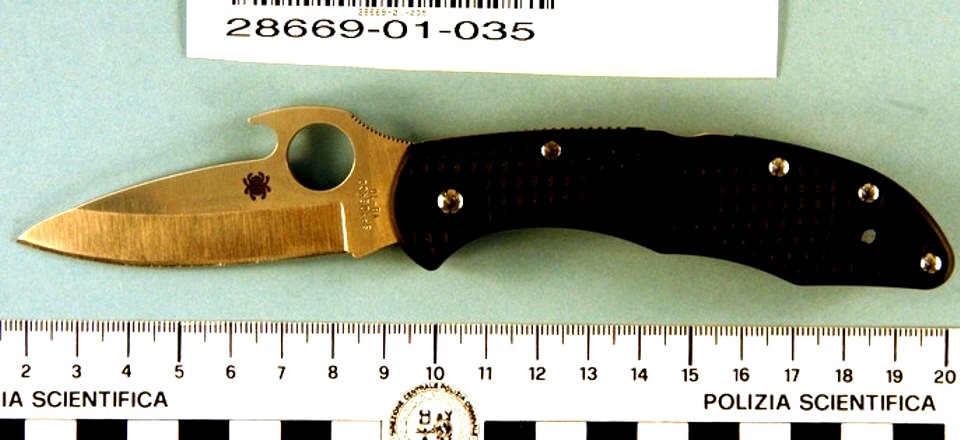
Sollecito’s “pocket knife” is a Spiderco Delica4 Emerson Opener made for killing people
Overview
This picks up from from my previous post just below on the large knife that overwhelming evidence shows was wielded by Amanda Knox.
Sometime around Thursday, January 30, 2014, Judge Nencini of the Florence Appeals Court will be delivering the verdict of the court in the case of Amanda Knox and Raffaele Sollecito, at which time all arguments regarding the knives, staged burglary, DNA and forensics, false accusation, wonky alibis, and reliability of witnesses will be rendered moot.
There will be nothing left but an argument about the legality of the process, and not the evidence, presented by the defenses if they choose to at some point in the fall of 2014 before Cassazione, the Supreme Court in Rome.
But, until then, we are left with the indelible image of Raffaele Sollecito’s defense attorney Giulia Bongiorno a few days ago flailing with two knives in court, arguing (1) the kitchen knife doesn’t fit the major wound, and (2) there’s a missing knife, which she suggested was a pocket knife wielded by Rudy Guede.
In part I, I proved that the imprint of the knife on the mattress sheet matched the kitchen knife, in shape and dimensions. We have already seen in other articles here on TJMK, that there is a definitive match with Knox and Meredith Kercher’s DNA on the murder weapon, and now we know it was transported to the cottage, to leave its mirror image on the bed.
Here, in part II, is a recap of Massei on the knives and wounds inflicted on Meredith Kercher, and how the defense continually tried to divert us away from the knife image by saying it did not fit the dimensions of the major wound.
Also we will have Frank Sfarzo and Bruce Fischer’s amateurish attempts to prove that Rudy Guede caused the knife wounds. And it will try to address what happened to the missing knife that inflicted the lesser wound on Meredith, and who might have wielded it.

Closeup of the stabbing end of the Spiderco knife shown at the top
Deliberate false claims
One of the many myths surrounding this case was that investigators had no reason to seize the kitchen knife from Sollecito’s flat, and when I showed the photos from Conti’s lab, with the deep scratches on it, that it may have been altered in some way, and denying that was where some of Meredith’s DNA might have been trapped. IIP even posted an out of focus picture some time back to prove that point.
Here is Frank Sforza on the late and unlamented Perugia Shock.‘ANY KNIFE COULD HAVE DONE THAT WOUND’
End of a Myth
Frank Sfarzo, Sept. 19, 2009
Quote: “It was introduced in the room, it was taken out of the box with all precautions, it was shown to them like a relic. They could have a look at it from a distance, and see, or believe to have seen, the groove into which the biological material of Meredith was found.” And:
“Amanda Knox’s lawyer Carlo Dalla Vedova brought him (independent expert Professor Cingolani) to say something very clear about the main one: any single-edge knife is compatible with Meredith’s larger wound.”
Here is Bruce Fischer on the error-ridden Injustice In Perugia.
Quote: “The knife was a common kitchen knife retrieved from the kitchen of Raffaele Sollecito. The knife was chosen from the drawer because it looked clean. (Editorial note: it was also, deeply scratched and nicked)
No blood was on the blade.
No DNA was on the blade.
The knife doesn’t match most of the wounds on Meredith.
The knife doesn’t match the bloody imprint left on the bed.
The photographic evidence shows that Raffaele’s kitchen knife is to (sic) large to match the bloody imprint on the bed.
At 4 cm from the tip the knife blade is 2.2 cm wide, while the injury (i.e. the small wound) is 1.5 cm wide. Raffaele’s kitchen knife could not have caused the wounds. The knife blade is also too long to have inflicted the large wound.” (Ed. note: Here they are conflating the dimensions of the lesser wound with the knife that inflicted the major wound, to cause confusion)
This is typical of the dishonesty of Bruce Fischer, who was only parroting what the defense experts had been saying in Massei’s court.
Fischer’s source was these posts from the now discredited Frank Sfarzo: Knife doesn’t match wounds and Knife doesn’t match imprint on bed.
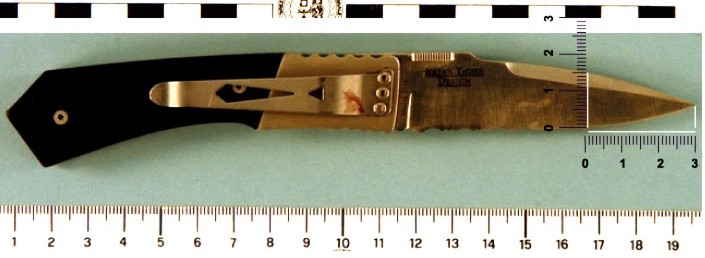
An image of Sollecito’s 2004 model Brian Tighe knife specifically made for killing people
From the Massei Report
This is from the excellent PMF translation.
P. 99: The witness (investigator) recognized it when shown Exhibit 36 as that same knife (pages 176 and 177, hearing on February 28, 2009). He remembered that in the drawer there were other knives, but he collected what was later indicated as Exhibit 36. It had the following dimensions: blade 17 cm. and handle of dark colour 14 cm. He recalled that in Sollecito’s bedroom they found another knife whose total length was 18cm, with an 8cm. blade.” (This would be his Brian Tighe pocket knife, the Spyderco flick knife was seized from his person when he was arrested)
P.135: The stab wound corresponding to the injuries on the right side of the neck was indicated as being a little wound of very small dimensions with a very small path. The path of the wound is 4cm long and only 1.5cm wide. The blade used to make this wound must have had a width of 1.5cm at 4cm from the point. This blade only entered 4cm into the neck “because it encountered the angle of the jaw” (page 33 of the transcripts).
P.147: Professor Vinci testified at the hearing of August 18, 2009. He considered the subject of the “bloody stains” found on the undersheet in Meredith Kercher’s room. In relation to these stains, on the basis of graphics given in the report dated June 30, 2009, he asserted that the knifeprint found on the undersheet in Meredith’s bedroom could have been made either by an 11.3cm knife blade, or by a 9.6cm knife blade together with a mark 1.7cm long left by the handle of the same knife. In either case, the blade could not be wider than 1.3/1.4 cm. (Ahem)
P. 154: Prof Cingolani: He clarified that irregularities present on the blade, on the edge of the blade, could have created the rippling in the wounds.
P. 157: the examination of the wound on the right part of the neck, which had absolutely incompatible dimensions: 1.5cm long and 0.4cm wide with a depth of 4cm.
p.164: she was therefore struck on the right latero-cervical region with a single-edged blade which produced a wound with dimensions of 1.5cm by 0.4cm, with a penetrating depth of 4cm: an action not relevant in determining the cause of death but intended, as before, to subdue Meredith Kercher’s resistance.
p.166: the width of the (kitchen knife) proximal third [blade one third of the distance from the handle] is 3cm.
p166: Along the edge, there was evidence of irregularities in the form of thin ridges at 2.2cm and at 11.4cm from the tip.
p. 167: The experts and consultants who were examined during the course of the trial, taking into examination the various wounds present on the neck, excluded the compatibility of the knife Exhibit 36 and the wound inflicted on the right latero-cervical and having the following dimensions: 1.5cm by 0.4cm, with a depth of 4cm in an oblique upwards direction. They in fact showed that the confiscated knife, at a distance of 4cm from the tip, has a width of approximately 3cm and thus almost double the 1.5cm width of the wound, a width thus incompatible with the dimensions of the blade of this knife.
p.172-3: In relation to the above, the thesis of the incompatibility of the most serious wound and the knife Exhibit 36 is held to be unacceptable, though this knife is incompatible with the 4cm-deep wound, as we have seen. Nor does this conclusion contrast with the circumstances illustrated by Sollecito Defence consultant Professor Vinci in his report relating to the “šanalyses of the haematic stained shapes discovered on the mattress cover in Meredith Kercher’s room”›.
p.175: The reconstruction offered by Professor Vinci certainly appears suggestive. Some doubt remains in the reconstruction of the dimensions of the knife derived in relation from the marks found on the bed sheet. If these marks indeed derived from the knife placed on the bed sheet, then they should in fact have been more abundant, and should have outlined the shape of the knife with greater precision, for the following reason: the knife, if it was placed on the bed sheet, was placed there immediately after it had been used to strike Meredith; therefore, the fresh and abundant bloodstains present on the blade should have been imprinted onto the bed sheet in a more evident and copious way than is actually appreciable. It cannot in any case remain unobserved that, if one of the knives used had a blade length of 11.3cm, or else 9.6 cm ““ according to what was indicated by Professor Vinci in the conclusions to his report ““ the argumentation set forth to sustain the incompatibility of the knife Exhibit 36 would not, on this alone, have any foundation.”
For the record, here are the paragraphs from the English translation of the Massei Report where Patricia Stefanoni describes the streaks and scratches on the double DNA knife and locations where samples were taken.
Judge Massei (on pg. 196) wrote about forensic expert Patrizia Stefanoni:
“She specified that trace B had been taken from a point on the face of the blade; she added that no biological trace was visible to the naked eye. However [she added that] “under considerable lighting, a series of streaks were visible to the naked eye. These streaks ran parallel to the upper part of the blade, therefore, more or less, they were parallel to this side [of the blade] and towards the point they went downward and, therefore, they followed the shape of the point. These streaks, anomalies in the metal, were visible to the naked eye under intense lighting” (page 95 of the transcript). Still in regard to the visibility of these streaks, she specified that they were “visible under good lighting by changing the angle at which the light hit the blade, since obviously the blade reflects light and thus creates shadows, making imperfections visible”.
The samples taken from the handle, in the points indicated with the letters A, D, F were taken in order to verify the possible presence of DNA by the person who grasped that knife. In particular, for sample “A”, a particular point had been chosen, “in which there’s the hand-guard” (page 95) and therefore, in all likelihood, the point where there was the most friction between the hand that grasped the knife and the handle. This sample yielded the result of Amanda Knox’s genetic profile.
The other samples yielded negative results, except the one taken from the blade, from the “scratches and streaks visible under good lighting, by changing the angle of the lighting with regards to the blade” that yielded the genetic profile of the victim (page 96 hearing May 22, 2009).”
And now we know: Dottora Patrizia Stefanoni got it right.
And some disagreement amongst the experts: p.291-2: Professor Cingolani had in fact noted and declared the following: “in the second lesion, the one that is 2 centimetres deep and 1.5 centimetres wide from corner to corner, the only thing that we are tempted to do, [albeit] in an absolutely amateurish/unprofessional way, because we only have photographs available, is to measure, assuming that only the tip entered, how wide the blade is [at a point] 2 centimetres from its tip: it is precisely 1.5 centimetres wide!”

A closeup with measurements of Sollecito’s Brian Tighe knife made for killing people
My own investigation
Here is my initial close examination first posted on PMF dot Net last summer.
Ergon Post subject: INVESTIGATION OF THE KNIVES USED IN THE MURDER Posted: Sun Jun 09, 2013 12:42 am
Investigation into the death of Meredith Kercher-THE CAUSE OF DEATH AND THE MEANS BY WHICH IT WAS OCCASIONED
The murder of Meredith Kercher was particularly bloody and brutal. Reading through Massei, pages 109- SURVEY AND EVALUATION OF THE FORENSIC RESULTS through to 158-173, THE CAUSE OF DEATH AND THE MEANS BY WHICH IT WAS OCCASIONED we are reminded of the brutality with which the attack took place, the sexual assault by more than one person, the restraining, the defensive wounds on Meredith’s hands, the torture by more than one knife, restraining by a hand over the mouth when she screamed, (even while she bled to death) and two major knife wounds, one to the left of the throat, the other, to the right. Massei rightly concludes, as did the Supreme Court, that more than one attacker was involved, and, per Massei, there was more than one knife used in the attack. The defense experts tried to draw attention away from the kitchen knife, but, reading through Massei again, I saw how they dropped clues to what the dimensions of the second knife might have been.
We know that Raffaele Sollecito had a fetish for violent porn, that he had an expensive collection of knives, and his many alibis for the night in question have been thrown out by the court. From my studies of criminal psychology, from reading both Amanda and Raffaele’s books and watching videos of their court appearances and television interviews, their psychopathology seem apparent not only to my eyes, but even to the general public that must have looked at them and decided their story somehow did not ring true, and refused to buy their books. There are indeed certain neurological deficits apparent in their demeanor that renowned German neurologist Dr. Gerhard Roth postulates shows up as a ‘dark patch’ in brain scans of all those who display criminal behaviour, and even, “The second type is the mentally disturbed criminal who looks at his world as threatening. A wrong look, one false move, he can explode and become a killer,” he said.
I was shown videos of the crime scene, and able to observe the wounds in Meredith’s neck. The scenes of the room in which the murder took place and, the neck wound, were truly horrifying to me, and showed the extent of the attack. Those images still sit in the mind, but also, cause me to want to get to the bottom of this mystery, hence, my work on the case.
I believe, observing the photos I already posted in the Evidence Files that the kitchen knife was the murder weapon that struck the fatal blow that night. I also believe, reading the pathologist’s report, that the blade that was stuck in Meredith’s neck, in the right latero-cervical area to a depth of 4 cms, was Raffaele Sollecito’s Brian Tighe pocket knife, photo also in the evidence files. Yes, no DNA or blood was sampled from it, but that only indicates it was successfully cleaned that night. My reading of Sollecito’s pathology is that he would not want to dispose of the knife he used, it being very expensive and also as an extension of his fetishistic ego. One other thing I asked to look at: The high resolution photos I posted of the bed show the outline and dimensions of two knives. I believe that both images are of the kitchen knife that struck Meredith in the left latero-cervical to cause a cut of 8-9 cms in depth, and a length of 8 cms (p. 167)
There are two exhibits of the mattress cover, one marked “J” and the other, “O”, both displaying the approximate size and dimensions of the kitchen knife, which I will explain when I post the photos. The first, “J”, has more blood because I believe the knife was placed there first and wicked on to the sheet, causing the distorted splotch at the end. By the time it was moved to its final position by the purse, “O”, it retained just enough blood to leave a clearer, indelible impression.
It was a butchery.”
One last point: Rep. 33A/B/C/D were four samples taken from a black-handled folding knife. It tested negative for blood, but, in one sample, the DNA profile matched a mix of Knox and Sollecito. The other samples were negative. Stefanoni: pp. 103-104
Looking at the images produced by my illustrator, and taking the average of the two estimates of the wound depth, 2 and 4 cms, one arrives at a blade width of 1.5 cms at 3 cms length from the tip of Raphaele Sollecito’s Brian Tighe collectors knife, on which, coincidentally, both Amanda Knox and Sollecito’s DNA was found.
Conclusion:
Raffaele Sollecito stabbed Meredith Kercher, causing the lesser wound. And my personal opinion? It was with the Brian Tighe knife, and somehow both he and Amanda Knox got their DNA on it around the same time that night.
Monday, January 27, 2014
An Investigation Into The Large Knife Provides Further Proof That This Was THE Knife
Posted by Ergon
Overview
This is the first report of an investigation (the second part follows soon) of the kitchen knife used in the murder of Meredith Kercher, RIP.
Specifically its compatibility with the imprint of a bloody knife found by police investigators on her bed under-sheet which as you will see here seems possible to prove.
Two other recent posts also concentrated on aspects of the knife as strong proof: (1) proof of both Knox and Kercher DNA and (2) proof from the throat wounds.
- Reference files are from very high definition crime scene photos not in general circulation.
- Grateful thanks to the volunteers of the Meredith Kercher community who assisted in this production
Florence Court of Appeals
This is our poster Machiavelli, tweeting from the Florence courtroom on November 26, 2013:
“(Prosecutor Alessandro) Crini stated that this kitchen knife was compatible with the knife print on Meredith’s bed sheet”.
And this is from the defense summing up on January 09, 2014:
Bongiorno: “It’s too big, not the murder weapon.”
“Bongiorno shows a picture with an envisioned “knife” (pocket knife belonging to Guede?) together with the print on the bed sheet.”
“Nobody brings a “small blow with a big knife” “You don’t use half of a big knife” (she says)
Genesis of an investigation:
To recap: evidence was been presented at the Massei court of the first instance, which accepted that the kitchen knife, containing both Meredith Kercher’s DNA on the blade (trace B) and Amanda Knox’s DNA on the handle (trace A) was the weapon that struck the fatal blow to Meredith Kercher’s throat.
At some point after the attack, the perpetrator, Amanda Knox, puts it down on the bed, leaving “hematic stains” (bloody imprints) on the mattress.
The court concludes the shape of the imprints are compatible with the kitchen knife. It also concludes, based on the size of a lesser wound that a second, smaller knife caused the wound on the other side of the neck, and, the impossibility of accepting that a single weapon inflicted both wounds.
This is what it boils down to now, as we come to the final arguments of this case on January 30, with a decision to be handed down by the court later in the day:
- Was the kitchen knife found in Raffaele Sollecito’s kitchen the murder weapon that killed Meredith Kercher on November 01, 2007?
- Did the killer leave behind proof in the form of bloody imprints on the under sheet covering Meredith’s bed?
- And is the defense trying to divert attention away from it, even though the image on the bed fits the dimensions of the kitchen knife?
- And pointing to a second knife, not ever found?
This article (to be followed by part II) was prepared to offer answers to these questions.
Methods used
As someone with a keen interest in photography, I know we see things in photographs that are not always apparent to the naked eye.
Where before we had all been misled by low definition photographs released by the defense to obscure incriminating details, I was able to obtain and view the high definition photographs shown here that proved that indeed, the bed imprints matched the seized kitchen knife, exhibit 36.
These photographs, first posted at Perugia Murder File Evidence Files have been circulating for some time, with members trying to match the knife to the bed imprints, but not, in my opinion, being able to match it exactly.
First, note that the killer placed a knife on two separate locations on the bed, marked by reference cards “J”, and “O”. (Reference photos below.)
I discarded “J”, because there was too much blood there to form an accurate measurement. The killer lifted the knife and then placed it at “O”, which gave a better image, but even then, did not match exactly. Still, it was clear the images looked like a kitchen, and not, a pocket knife as alleged by the defense.
Looking at the reference photo, I saw a double image of a knife blade at “O”. (see where there’s a curved edge of the blade? That’s what convinced me there might be a double image there)
Conclusion reached
My opinion is the knife shifted slightly when it was placed there, hence the double image, which now made a perfect match with the kitchen knife, in both instances (see reference photos).
So I got a professional illustrator and other skilled people people to do the scale drawings and produce the video you see above which seems to provide conclusive proof the murder knife was placed on the bed.
Reference photos:
Image 1 above (click for larger image): Bed II (Image J and O on under sheet, shot November 02, 2007)
Image 2 above (click for larger image): Knife II (Image O on under sheet, shot November 02, 2007)
Image 3 above (click for larger image): FOTO5BIS (Conti-Vecchiotti lab, Mar. 22, 2011)
Image 4 above (click for larger image): Knife-Bed-Vector-AllScales (To prove the scales used to match the images)
Image 5 above (click for larger image): Knife-pos-lower-hi (The knife’s first resting position at “O”)
Image 6 above (click for larger image): Knife-pos-upper-hi (The knife’s final resting position at “O”)
Next steps
There are only four more days left till the Florence Appeals Court under Judge Nencini issues its verdict. It must of course consider ALL the evidence, of which there is a preponderance that indeed suggests the verdict will, as would be proper, be guilty as charged.
Part II will be ready ASAP. It will be a recap of Massei on the knife, and how the defense continually tried to divert us away from the knife image by saying it did not fit the dimensions of the major wound. Also will have Frank Sfarzo’s misdirection and Bruce Fischer’s amateurish attempts to prove that Rudy Guede caused the knife wounds.
Happy as always to do my share for justice for Meredith Kercher.
Monday, January 20, 2014
Appeal Session #9: Sollecito Team Concludes, Prosecutor Crini Rebutts Defenses’ Claims
Posted by Our Main Posters
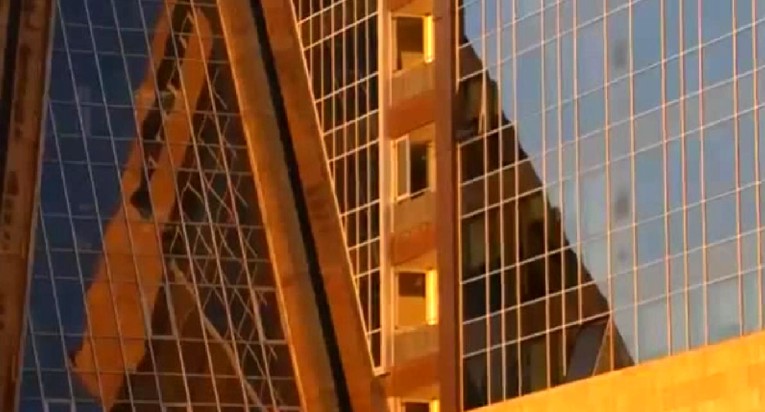
[Above: Sun hits the facade of of one of the most modern courtrooms in Europe]
5. Andre Vogt’s Excellent Post-Court Reporting In The Week
From Amanda Knox’s fugitive fears: she’s right to be worried
Sources close to defence lawyers confide that they, too, fear it may not go their way.
It didn’t help that Knox ignored her lawyers’ pleas to travel from Seattle and attend court in Florence - she sent an email instead - nor that she repeatedly requested to meet the Kerchers, only to be sternly rebutted by their lawyer, who suggested she act more like a defendant.
Then she started a new blog and began blithely responding to comments ““ most recently posting an admission that she had once faked a break-in as an April Fool’s prank before she left for Italy (a staged burglary is a key part of the case against her).
Have the wheels come off Knox’s public relations machine now that she’s safe in Seattle? She may need them again soon, because this appeal differs radically from the first one in 2011 which resulted in her acquittal, but which was harshly criticised and eventually annulled by Italy’s Supreme Court earlier this year.
There are three good reasons why this trial is different ““ and why Knox has reason to be nervous:
First, her co-defendant Raffaele Sollecito’s lawyers have distanced his defence from Knox’s. “He may have brushed her hair and cleaned her ears, but he would not have killed for the love of Amanda,” his lawyer Giulia Bongiorno told jurors in closing arguments earlier this month. “Turn off Amanda,” she said. “Raffaele is not Amanda’s other half.”
Second, the uncompromising Perugia prosecutor Giuliano Mignini has stayed away from Florence. Without him in court as a convenient villain, the “innocent American abroad being railroaded by a rogue prosecutor” narrative no longer holds water. The Florentine prosecutor, Alessandro Crini, has distanced the state’s case from the always controversial kitchen knife that may or may not have been the murder weapon. He’s also given less credence to the “˜sex game gone wrong’ theory that was central to the prosecution case in the first trial. Instead he’s considered all the evidence as a whole. There might have been a fight about missing money and hygiene, he said, but motive doesn’t matter: murders happen all the time for banal reasons. And convictions happen on much less evidence.
Third, the strict Florence judge, Alessandro Nencini, has curbed all antics by lawyers, public and media. There are no perp walks with popping flashbulbs this time. However the appeal ends, no one can argue that this trial wasn’t professionally managed.
4. Tweets by freelance reporter Andrea Vogt
14. Sollecito defense on bra clasp: For us, the condition of the room and conduct of the forensic police tells us there was contamination.
13. Judge interrupted Sollecito lawyer with a booming “No!” saying wiretapped conversations of Sollecito family not to be discussed this trial.
12. Maresca: Whatever you decide, we believe justice will be done & all elements considered in depth. We will serenely accept your decision.
11. Kercher attorney Maresca: Perugians reacted angrily to amanda knox acquittal because it was scandalous: acquittal was decided in advance.
10. Fabbiani, attorney for Meredith’s brother, urges court to look beyond motive. Perna for her sister: one person alone did not kill Meredith.
9. Lumumba attorney Pacelli concludes with this phrase to the jury: “Convict liar Amanda, the diabolical slanderer.”
8. Presiding Judge Nencini has cut Pacelli’s amanda knox monologue short. Says going off track. Pacelli promises to finish in 5 min.
7. Lumumba’s attorney Pacelli is delivering a vitriolic rebuttal on amandaknox - mixing his unbridled contempt w/her own statements.
6. Prosecutor asks (in case of conviction) cautionary measures so defendants can’t flee. Options are: passport, house arrest or arrest.
5. Prosecutor Crini: a lack of motive does not equal proof of innocence.
4. Trial back in session after “pausa caffe” during which Sollecito and his accusers were in tiny court coffee bar at same time. Only in Italy!
3. Sollecito attorney: The only things certain are the death of Meredith Kercher and the presence of Rudy Guede in the house that night.
2. Sollecito attorney: This case is an anomaly. Various judges interpreted facts differently over the years. There’s reasonable doubt.
1. In court, Sollecito attorney Maori contesting prosecutor’s arguments point by point. Knife, bathmat, alibi, witnesses. Afternoon rebuttals.
3. Tweets by our main poster Machiavelli
[At this point Machiavelli signed off]
62. Crini: Nencini asks the clerk’s officer to write down formally the exact terms of prosecution request to issue cautionary measures [if verdict guilty]
61. Crini says his conclusions are unchanged. Prosecution suggests arrest decrees are issued immediately if defendant(s) is(are) guilty
60. Crini points out the crime and motive originate from group dynamic.
59. Crini: Bongiorno had pointed out that anyway Sollecito should be accounted only for what he had done (implicit: not what Knox did)
58. Crini: The excessive and too quick reaction to a situation of rising argument is typical of group reaction.
57. Crini: Argument about cleaning was also reported by Meredith to her father John Kercher
56. Crini: Massive rejection of English [girls] testimonies is “weak” on the part of defence; tensions and dislikes in the house are recorded on paper
55. Crini: Movite cannot be assessed preliminarily as if it was a piece of evidence to be discussed
54. Crini: if you need to prove a crime, it is opportune to detect a motive, but a motive is only a plausible conjecture not basis for deduction
53. Crini: Bongiorno called all English girls ‘unreliable’ (because English, maybe coached by lawyers etc.)
52. Crini calls ‘amusing’ Bongiorno comparing her client with captain Schettino
51. Crini: Some thoughts about the motive.
50. Crini: It makes no sense to say the large kitchen knife is ‘incompatible’ with the big wound.
49. Crini: To the court: can you imagine a ‘surgical operation’ with a small knife producing a wound with clear margins on a live struggling victim?
48. Crini: it is difficult to produce an 8x8 cm large wound with a small 8cm long knife, it would produce at best a wound with irregular margin
47. Crini: The blade hypothesized by defence from the bed sheet stain is anyway larger; these are anyway conjectures. Datum is compatibility
46. Crini: thinking you can preemptively deduce the size of the blade from bed sheet stain is ‘unrealistic’
45. Crini: The “double knife theory” is based on the small size of the right wound, experts point to a likely much smaller knife with thin blade.
44. Crini: no defence wounds, no fight bruises, nothing under nails, bruises indicate forced restraint of victim; how she was immobilized
43. Crini: Massei court did not decide about attribution of pillowcase shoeprints, Crini objects Vinci’s finding, thinks prints are too small
42. Crini: Knox defence: says when Guede leaves palm print on pillowcase leaves a signature
41. Crini: Bongiorno called the murder scene “flooded” with Guede’s DNA. Crini points out his traces in room indicating he had free hands (no weapon)
40. Crini: The defences also dealt thoroughly with the use of the knife, wounds, blade size
39. Crini: The dynamic of the crime. Maori attributed all traces to Rudy Gede alone
38. Crini: All alleles of the victim were found in a scratch on the knife blade. Human DNA is normally not on knife blades
37. Crini: Vecchiotti admitted there was a scratch on the blade
36. Crini: The same defence experts did not object to the attribution Y haplotype of Guede found in the victim’s vagina
35. Crini: Calls Vecchiotti’s reasoning on bra clasp “a priori”, dismissed for reasons totally general and vague. Doesn’t read Y haplot. and X together
34. Crini: Points out a passage where Vecchiotti’s report misquotes police findings inserting the word “only”, built a strawman
33. Crini says let’s look at the Conti-Vecchiotti report, to see what it says, if you can subscribe with the report.
32. Crini: Tagliabracci in 2008 objected to quotes of prof. Gill calling them “too recent”
31. Crini: Objections referred to Low Copy Number are obsolete, and also partly undermined by the RIS report
30. Crini: Calls “embarassing” Bongiorno when alleges the police was wrong in attributing stains to cat’s blood
29. Crini: Disproves Bongiorno’s allegation that the clasp was stepped over.
28. Crini: Novelli rules out there was contamination in laboratory, as well as tertiary transfer in situ.
27. Crini is “pleased” the defence did not attempt to allege laboratory DNA contamination. Points out findings by Novelli
26. Crini: report says had there been internet surfing or writing activity, this would have resulted as obvious.
25. Crini cites arguments about computer expert reports, hearings of 14 Mar 2009 and Dec 2010 say further investigation is unnecessary
24. Crini: Maori omits to quote pieces of Curatolo’s testimony.
23. Crini will deal with Maori’s “theory of alibi” only very briefly
22. Crini says defence arguments on bathmat print are conjectures. Rinaldi is actually same person who correctly attributed shoeprint
21. Crini: Bathmat print: compatibility assessment can be done on what is measurable
20. Crini: Guede knew the hous and apartments, would have chosen logical entries and logical behaviour, Crini calls burglary theory ‘not credible’
19. Crini: alleged small wounds on Guede’s hand, inconsistent with absence of his blood on scene
18. Crini: Talks about Bongiorno’s criticism to staged burglary scenario - the scenario of Guede already inside apartment
17. Crini says police report timings, records of CCTV video camera and phone calls are ‘consistent’
16. Crini does not see corroboration of alleged 7-minute late clock error of CCTV. The 13.29 call was from Carabinieri HQ and don’t change anthg
15. Crini tris to “strain” the timing of police arival to favor the defence, to see if scenario fits. Considers possible CCTV time error
14. Crini: Sollecito calls Carabinieri too late, also because last phone call to Romaneli was at 12.38
13. Crini: Call to Sollecito’s sister, and then Sollecito’s call to Carabinieri at 12.51-45. Crini: this timing is late independently from Battistelli
12. Crini: Battistelli arrives on foot about 10 minutes eariler than postal police car
11. Crini wants to look better at some arguments about Sollecito’s declarations to postal police. Battistelli recalls 12.35 consistent with CCTV
10. Crini talks about Sollecito ‘sidetracking’, talking about statements to postal police
9. Crini: Knox’s Calunnia also contains details that have external corroboration and she could not have deduced from simple burglary scenario
8. Crini: A Calunnia is itself incriminating (require strong defence explanation), but Knox’s Calunnia also contains furth incrimiating details
7. Crini: Knox maintained her calunnia against Patrick over a period of several days. Crini points out the logicality of Cassazione argument.
6. Crini: Knox statements: ‘Patrick had sex with Meredith’ and ‘there was a loud scream’ were new elements, unrelated to known facts and not retracted
5. Crini: On calunnia, Crini points out that there was an argumentation about Knox defence about usability of Knox’s statement. argument is wrong
4. Crini: Theoretically all defense points could be replied to, Knox’s Calunnia, Sollecito statements to police, the staged theft, the mat print; DNA evidence
3. Crini says he will talk briefly only about a few selected points, without repeating himself, and without discussing old arguments again
2. [After the break] Prosecutor General Crini begins to reply.
1. [After the break] Sollecito entering the court, asked what he expect, says “no comment”
2. Tweets by reporter Barbie Latza Nadeau
44. Judge especially hard on Sollecito sub lawyer, reprimanding her for introducing new arguments when she is only supposed to be refuting.
43. Sollecito sub lawyer argues no DNA from Meredith Kercher on bra clasp w/Sollecito’s DNA, failing to mention she was wearing the bra..
42. Six years of Kercher trials and some lawyers still pronounce the K in Knox.. “ka-nox” as Sollecito’s sub lawyer just did.
41. Kercher lawyers finished, now Sollecito lawyers up for rebuttal, but both his principal lawyers had to leave early.
40. Kercher atty Maresca: Perugians reacted angrily to Amanda Knox acquittal because it was scandalous: acquittal was decided in advance.
39. Kercher lawyers ask court to consider all the previous testimony they say proves more than one person killed Meredith Kercher.
38. Lumumba lawyer says his client has not received any of the €22k he is owed by Amanda Knox even though the slander conviction is final.
37. Judge reprimands Lumumba lawyer for veering off course, he is only to discuss slander aspect of case, not murder itself.
36. Lumumba’s atty Pacelli is delivering a vitriolic rebuttal on Amanda Knox - mixing his unbridled contempt w/her own statements.
35. Lumumba keeps referring to Amanda Knox as “the American”, says she had a penchant for drugs, alcohol, sex.
34. Lumumba lawyer calls Amanda Knox a “diabolical slanderer” “¦
33. Lumumba lawyer says Amanda Knox substituted Patrick for Rudy Guede.
32. Court back in session with Lumumba lawyer up. Sollecito back in court after break.
31. Prosecutor Crini: a lack of motive does not equal proof of innocence. Amanda Knox
30. Prosecutor focused on knife, says traces of Meredith Kercher and Amanda Knox are valid.
29. Sollecito staring at prosecutor as he delivers rebuttal, jury taking notes, judge listening intently, journalists trying to stay awake.
28. Prosecutor in new Amanda Knox appeal says motive in murder is never simple and clear, like murder itself is complex.
27. MeredithKercher lawyer says her brother and sister plan to come for verdict Jan 30.
26. Prosecutor just referred to Amanda Knox as “la nostra Knox” as he tries to refute defense arguments.
25. Trial back in session after “pausa caffe” during which Sollecito and his accusers were in tiny court coffee bar at same time.
24. Prosecutor making brief rebuttal, pushing Sollecito and Amanda Knox back together after Sollecito lawyer clearly tried to separate them
23. Sollecito just told group of reporters he was not sure if he would come for verdict.
22. Sollecito lawyer finished. Judge asks lawyers how much time they need for rebuttals. 15 minute
21. Sollecito lawyer says his client is not guilty. Does not mention Amanda Knox in final moments of closing arguments.
20. Sollecito atty: This case is an anomaly. Various judges interpreted facts differently over the years. There’s reasonable doubt.
19. Sollecito lawyer tells the court they can only accept that Meredith Kercher was murdered and that Rudy Guede is the lone killer.
18. Sollecito lawyer G Bongiorno has just arrived in court with three male assistants.
17. Sollecito lawyer says Sollecito was never with Guede, Meredith Kercher and Amanda Knox. Says testimony that they were was false.
16. Sollecito lawyer working to discredit witnesses. Says store owner who says he saw
15. Judge in response to Sollecito lawyer asking if jury is tired: if we are tired now we will have to kill ourselves by the end of the day.
14. Sollecito in court today. Will he come for verdict on 30th?
13. Sollecito lawyer lays out why homeless man in park who testified he saw Amanda Knox and Sollecito arguing night of murder is unreliable.
12. Patrick Lumumba also absent from court today.
11. Judge in Amanda Knox new appeal rarely looks at Sollecito lawyer, writing notes, scrolling tablet, but minimal eye contact.
10. Sollecito lawyer on mass media tangent, says the “super witnesses” for prosecution in earlier trials were all for show.
9. Judge in Amanda Knox 2nd appeal asks for clarification on hard to follow techie evidence.
8. Sollecito lawyer showing computer records for Raf’s computer access, says access was human, not automated. Jury squinting at slides.
7. Sollecito lawyer moves on to Raf’s computer, how computers belonging to Amanda Knox, Meredith Kercher were all “accidentally” destroyed.
6. Sollecito lawyer back on break in. Frequent reference to Guede “the real assassin”. No mention of Amanda Knox at all yet.
5. Sollecito lawyer focusing on staged break in.
4. Sollecito lawyer G Bongiorno not in court this morning.
3. Sollecito lawyer Maori says luminal also picks up fruit juice, not just blood. Judge taking notes.
2. Sollecito lawyer showing slides of famous footprint on bathroom rug in Meredith Kercher blood.
1. Sollecito lawyer now summing up in Florence, then rebuttals. Verdict expected Jan 30.
1. Tweets by reporter for La Nazione
46. Lawyer Colotti (Sollecito) : “In a process based on circumstantial evidence motive is the glue of the whole thing.”
45. Lawyer Colotti (Sollecito defense) begins.
44. Sollecito defense : “The Meredith’s bra clasp was contaminated as evidence “
43. Sollecito defense : “It was Rudy Guede who entered through the window after breaking the glass “
42. Sollecito defense : “There was no misdirection in statements of Sollecito “
41. Now it’s up to the defense again, Sollecito team begin their final responses
40. Lawyer Maresca (Kerchers) : “On the blade there are traces of the victim “”
39. Lawyer Maresca (Kerchers) : “Hellmann appeal, the acquittal was a pre-cooked judgment”
38. Lawyer Francesco Maresca (Kercher family) begins
37. Lawyer Perna (Kerchers) “Wounds on the body victim compatible with the knife found at Sollecito’s house “
36. Lawyer Perna (Kercher family) begins
35. Lawyer Vieri Fabiani , one of the lawyers for the plaintiffs, the Kercher family
34. Lawyer Pacelli (Lumumba) : “Judges, sentence the liar Amanda , the devilish slanderer “
33. Lawyer Pacelli (Lumumba) : “Meredith could not stand Amanda”
32. Lawyer Pacelli (Lumumba) : “Amanda is on Lumumba’s mind constantly “
31. Lawyer Pacelli (Lumumba) : “Amanda hoped Lumumba slander would not be discovered “
30. Lawyer Pacelli (Lumumba) : “the defense of Amanda was rancorous and non-existent “
29. Lawyer Carlo Pacelli (for the plaintiff Lumumba) begins.
28. Crini: “If Sollecito and Knox are condemned then precautionary measures should be decided to ensure execution of the sentence”
27. Crini: “There were tensions in the house for reasons of hygiene ”
26. Crini: “The absence of sure motive is not a defensive threshold “
25. Crini : “At the scene there was no contamination “
24. Crini : the prosecutor carries on his indictment reaffirming the validity of the clues
23. Crini : the prosecutor continues rebuttal, the Tuscany Attorney General Dr Tindari Baglione enters the court
22. Crini : “Slander of Lumumba in itself is an important element “
21. Crini : the Prosecutor General starts his rebuttal
20. Sollecito’s father::”That’s understandable , too much stress”
19. Sollecito :”I do not know if I’ll be in the courtroom on the day of judgment
18. This ends the argument of Maori (defense of Sollecito )
17. Maori: “The only possible verdict is an acquittal”# meredithnazione
16. Maori: “In the various processes motive , time, and the murder weapon changed ontinuously”
15. Maori: “The witnesses who say that Raffaele and Rudy knew each other, said things false”
14. Maori:”The witness Quintavalle for many days after the murder of Amanda did not speak”
13. Maori: “The witness Quintavalle speaks thirteen months after the fact”
12. Maori: “The witness Curatolo is unreliable , wrong date and report things that are false”
11. Maori: “Some witnesses have had access to financial sinecures”
10. Maori: “The witnesses are characters created by the mass media”
9. Maori: “At 21.26 Sollecito opened from his PC the cartooon Naruto”
8. Maori: “At 21.10 there was interaction Sollecito with his pc”
7. Maori: “Analysis of the computer shows that Sollecito ‘s alibi is true”
6. Maori: “No simulation , glass window broken by a stone from the outside. No glass outside”
5. Maori:”No simulation of theft. Blinds on window with broken glass were not closed”
4. Maori: “The bloody footprint on the bath mat is not Sollecito’s foot”
3. Maori: “Meredith was killed at 21”
2. Maori: “The kitchen knife is the murder weapon . Wounds are not compatible”
1. The hearing begins : now it’s up to the lawyer Maori
[Below: previous image of Attorney General Dr Tindari Baglione who is in court to hear Dr Crini]
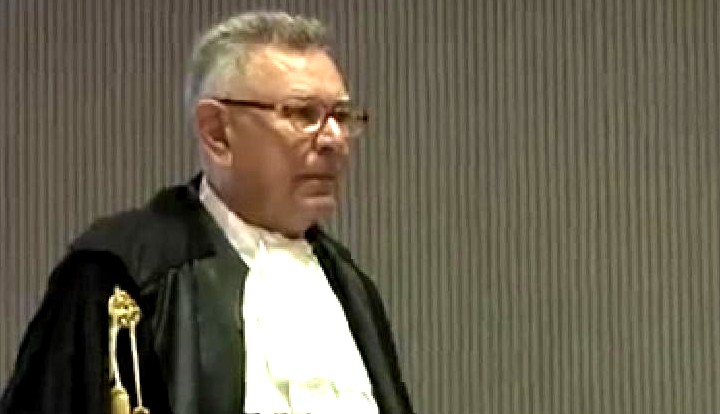
Saturday, January 18, 2014
False Claims In Bongiorno’s Summation: That The Wound “Proved” Sollecito’s Big Knife Was Not The One
Posted by Our Main Posters
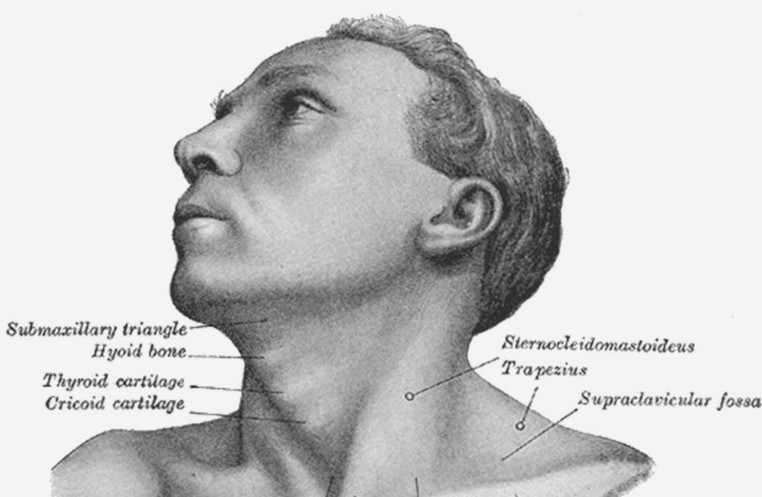
In defense summation on 9 January, nobody who really knows the case (such as Judge Nencini) would have bought many of Giulia Bongiorno’s outlandish arguments.
The post below this one illustrates how Bongiorno in about half her arguments tried to demonize and mischaracterize all of Perugia, as if somehow Perugia itself had become the real villain in forcing a rush to judgment and wrong conclusion. In fact Perugia took a huge hit from Meredith’s murder but has acted gracefully and competently ever since.
This post by several of us after discussion in Comments is the first of two on Bongiorno’s claims about the large knife. The second one will follow next week by Ergon.
There is no question in our minds but that this IS the murder weapon. It was proved convincingly by way of the DNA tests done by the Scientific Police and Carabinieri. Here we prove it by way of human physiology and the autopsy.
Waving two knives with a manic expression, Bongiorno claimed that the the large knife in evidence was far too large for the wound in question - and anyway, anyone intent on murder would have easily pushed the large knife right through so there was no intent of murder anyway. Bongiorno dismissed the possibility that hyoid bone could have somehow stopped the blade, prevented it from penetrating, as the bone is not resistant enough.
The surface location of the hyoid Bone is shown in the Illustration above; its front is only a few millimeters below the skin: The hyoid bone is loop-shaped like a C, open at the back; this Hyoid loop encloses part of the airway:
The hyoid bone curves around the upper airway at the base of the tongue, and is also called the tongue-bone or the lingual-bone. It is located between the mouth and the larynx; therefore during inhalation air passes through the hyoid loop before it passes through the larynx, and during exhalation air passes through the larynx before it passes through the hyoid loop.
The hyoid is an integral factor in the swallowing, breathing, and phonation mechanisms. If transected in such a way as to connect its part of the airway directly to the atmosphere, as it was in this case, swallowing, breathing, and phonation will be seriously impaired, as they were in this case.
The coexistent bleeding from the also-transected Right Superior Thyroid Artery accelerated Meredith’s death, more by the drowning-effect of inhalation of the blood into her lungs, than by the loss of circulating-blood alone.
Both the hyoid bone and the jawbone are mobile, which is why we can chew, swallow, talk, smile laugh, and sing, the way that we do, each of us in our own unique way.
The Massei Prosecution Reconstruction depicted the killers making cuts obliquely from behind.
The fatal cut started on the Left, but crossed the midline to the Right.
Both the Right Superior Thyroid Artery, and the nearby Hyoid Bone, were severed but from Massei, it is not precisely clear where the hyoid loop was severed, and it seems that the cut did not include the midline skin; The Florence Appellate Court will have access to the relevant records.
Here is why the hyoid could not have damaged any knife:
It is an old rule of materials-physics that a softer substance cannot even scratch a harder substance.
[To some people this may be counter to their intuition, so I have passed it by an eminent MIT physicist, and he agrees with me that the knife blade would not show signs of damage caused by the stabbing in this case.]
As pointed-out recently on TJMK, some confusion has arisen, caused by a quotation in the Massei Report, where on p371is written: “”¦a single blow was apparently halted by the jawbone”¦”
The statement that a blow could be “apparently halted” by Meredith’s jawbone is at best a figure of speech, and the quotes of Prof Cingolani on page 152 of the Massei Translation clearly indicate that any cause and effect inference from the phrase “apparently halted by” did not mean it was stopped-by the jawbone:
Prof Cingolani “did not, however, have elements of certainty to establish that the blade which had caused the wound 4 centimetres deep had stopped at the said depth because [it was] stopped by the jawbone.”
Maybe there is a Judicial, translational, or typographical glitch and “by” the jawbone should have been “at” the jawbone.
Skin is soft and bone is harder but there is no way that the knife striking the jawbone would halt the knife in this case, the jaw would just roll with the strike, depending on the angle of attack. [The force was not even enough to mark the jawbone itself!]
Furthermore, contact between the knife and jawbone or hyoid bone would not mark the knife because living-bone is softer than the knife.
When your pet gnaws on a non-living cow-bone, neither the bone nor your pet’s teeth can bend; both your pet’s teeth and the bone can be broken or dislocated, and the bone gets scratches on it because it is still softer than the teeth, but your pet’s teeth do not get scratches on them, because they are harder even than the non-living bone.
If someone is stabbed in the back with a kitchen carving knife, penetrating ribs on its way to the heart, the knife may have no scratches at all, nor show any signs of damage caused by that action.
[Look at your own kitchen carving knife. It probably has no marks caused by striking chicken thigh bones. It will have fine parallel scratches created in the manufacturing process.]
Any implication-in, or inference-from the statement quoted above that stabbing Meredith’s neck with enough force to penetrate the layers of her neck and then strike bone would have the effect of signs of damage to the knife-blade is a figment of an uninformed imagination.
The kitchen-knife, found in Sollecito’s apartment, with Meredith’s DNA on the blade and Knox’s DNA on the handle, is the weapon that killed Meredith.
Thursday, December 05, 2013
With Sollecito’s First Plea For Mitigation Seen As A Flop, His Behavior Seems Extremely Suspect
Posted by Peter Quennell

Sollecito headed for Dominican Republic, but stopped pending court okay
1. Post Overview
A week ago Prosecutor Crini had begun a two-day summary of the state’s case so stark and implacable that it had two effects on Sollecito.
He stayed in his hotel on the second day; and he then took off like a rabbit for some destination initially unknown and repeatedly lied-about by his father (see Part 3 below).
One of his lawyers (accidentally?) broke the secret. Sollecito had flown to the Dominican Republic. Where he just happens to have some really unsavory relatives.
2. High Drama In The Nencini Court
Sollecito has not ever taken the witness stand.
And given the minefield his foolish book and media claims amount to, don’t hold your breath expecting otherwise soon. However, last month Sollecito did use the Italian accuseds’ privilege of making an impromptu plea to the judges.
He was not under oath and not subject to cross-examination by the prosecutors. He did not address the copious evidence, and was seen as attempting to humanize himself to perhaps get some years knocked off a final sentence.
As always, Knox forces were left confused, thinking he had somehow helped both of them. But Sollecito repeatedly drew attention to his being an Italian and in effect to Knox and Guede not being Italians, thus once again separating himself from Knox on lines Barbie Nadeau also described here..
Our main poster Yummi was in the court and reported in part as follows:
One of the woman judges kept staring elsewhere and almost never watched Sollecito all the time he was talking. Sollecito’s speech itself was actually not that exciting. It was so overt that he was focused on portraying himself as a person who is so good and cannot hurt anyone, not the bad guy described in the media. The real and only topic of Sollecito’s statement was himself, who he is, his “true” personality, he begged them to look at what a good and suffering a boy he is…
And believe me, Sollecito was just whiny. For a big part of his speech he was just putting distance between who he is today and the person he was when he was 20 years old. He talked about the impossibility of finding a job (the job he would like to have in a corporation, obviously, not just any job) and wanted the judge to project to his condition from that of young Italians who can’t hope to see a future.
Then 10 days ago the skilled senior prosecutor Dr Alessandro Crini fired back, and effectively demolished Sollecito’s premature statement. As we reported, Dr Crini took nearly two days to do that.
Sollecito was again in court on the first day, but was seemingly unable to face Dr Crini’s onslaught on the second day. He remained holed up at his hotel.
Although Dr Crini settled on a lowest-common-denominator motive - a Lord of the Flies flare-up which had escalated into mob violence and the fatal stab to Meredith - his recounting of the evidence and associated behavior of the pack was comprehensive and very hard. Translated from Cronaca:
Meredith was treated “as if she was an animal.” In this way Dr Crini defined the dynamics of the murder of Meredith Kercher during his indictment.
According to Dr Crini, the attack escalated to the point where the attackers felt they “needed to get rid of a girl they had abused”. While Rudy Guede sexually abused Meredith Kercher, supine on the floor of her room, Raffaele Sollecito and Amanda Knox, according to the reconstruction, were at each side of the body of the victim.
“The mouth and neck of the victim were contained in a fierce way to avoid Meredith going berserk and screaming, and when Meredith did in fact manage to scream, she received the final fierce stab to the throat.” Two knives were used in the crime at the house in Via della Pergola on the night between 1 and 2 November 2007”...
Dr Crini referring to the bra clasp of the victim, said that “the presence of the DNA of Raffaele Sollecito is quite certain” and explained at length why there was no “possibility of contamination”.
Amanda Knox was at the scene of the crime, according to the identification made “‹”‹by the scientific police in Meredith’s room of an imprint of a shoe (female size 36-38 according to the results of the analysis)... On the pillowcase, the center of gravity of this bloody history, were found a palmprint of Rudy Guede and this print of the shoe.”
3. High Drama Right After End Of Court
Dr Francesco Sollecito was reported as being shocked by the unrelenting tone of the indictment. However, Sollecito’s plight is not nearly as bad as the ever-stubborn Amanda Knox’s.
Knox has already served three years and was fined heavily for obstruction of justice. She could face another year for that if it is found to have been aggravating. And as the post below mentions, she could face as many as three more charges for aggravating obstruction of justice.
Sollecito in contrast has respected the court by actually showing up, and, unlike Knox, has lately shown restraint in accusing his accusers.
However, the day after Dr Crini ‘s startlingly powerful summary of the case against him, it looked like Sollecito was hastily taking off out of Italy for somewhere.
La Nazione reported that police at Florence Airport had held back a fully loaded Air France flight to Paris while they checked with the prosecution that he was indeed allowed to leave the country. La Nazione said the prosecutors have some concern that he might skip and not come back, but he did voluntarily come back previously from the Dominican Republic, and his family has always ensured some presence in court.
But next TGCom24 reported that Sollecito’s father had claimed that Sollecito had already gone home to Bisceglie, although he is a free citizen still in possession of a passport and can travel anywhere if he wishes.
But then TGCom24 reported that he had indeed flown to Paris, but had turned around and come straight back again, to stay with family friends. And that on 8 December he will sit his final exams in computer science at the University of Verona.
However, soon after that La Nazione reported that Sollecito’s father had been contradicted by his lawyers, and his erratic son had slipped through his fingers and flown “for his work” back to the Dominican Republic. Translation by Jools:
1 December 2013 ““ SCOOP. Denials, lies, game by the defenders. But in the end it’s up to the lawyer Luca Maori to admit: “Raffaele Sollecito returned to Santo Domingo, as anticipated on Friday by La Nazione”
He embarked from Florence’s Peretola Airport and made a stop-over in Paris, from where he then flew to the Caribbean island where he spent the last few months that preceded the start of the new appeals process. “But there is nothing strange - minimizes the lawyer - Raffaele went back to pick up the things he left there, will be back in ten days for the final exams and to await the judgment. With anxiety, but self-assured.”
No escape, just a normal “work” trip. Permissible, since there is no measure that prevents the accused to leave Italy. But the departure of Sollecito, accused of the murder of Meredith Kercher along with former girlfriend Amanda Knox (already sheltered in the U.S.) caused some sneering. And even the agents of the Border Police, when they saw him in front of the [departure] gate, made a phone call to the Procura to be sure whether the journey in the midst of the appeal process was really “normal.”
IN FACT. Sollecito ‘s father, in an understandable effort to defend his already too overexposed son, slipped on the so-called banana peel, placing the young man within a few hours in various locations, but never in the true destination across the ocean: in Verona, preparing for the final exam in computer science in regard to the thesis, or in Paris, but just for a flash-stay from which he was back the day after. At Christmas, maintained the father, Raffaele will return from abroad. Maybe for the last break before the final rush of the Mark II process, which, according to calculations by the Assize Court of Appeal, could be concluded on January 15.
Meanwhile, the hearing on 16 December is for the remaining civil parties, then double date for the defence, (December 17 and January 9) and hearing on the 10 dedicated to counter-argument. With Sollecito in the courtroom, assures the lawyer.
Nothing strange?! Doctor Sollecito lying repeatedly, instead of explaining to the media where Raffaele went, and why he went there, and why it was a huge secret, was VERY strange.
It should have official minds very seriously wondering why. WHAT did Raffaele have to do so secretly in the Dominican Republic - where his notorious mafia relatives from Montreal occupy a town there?

